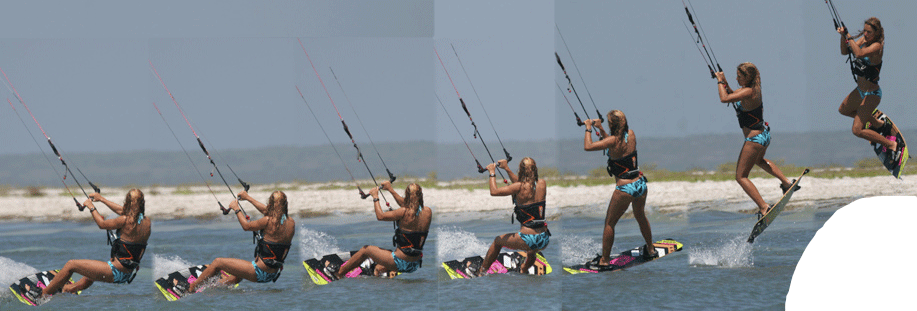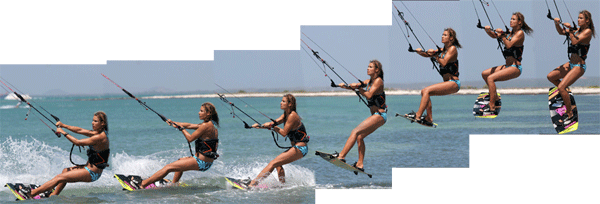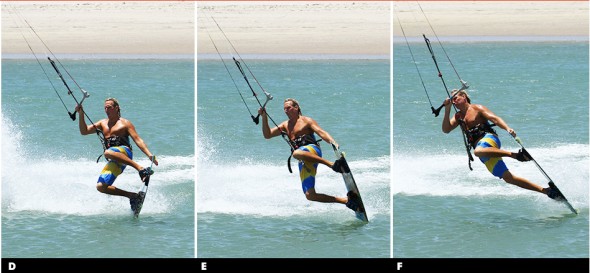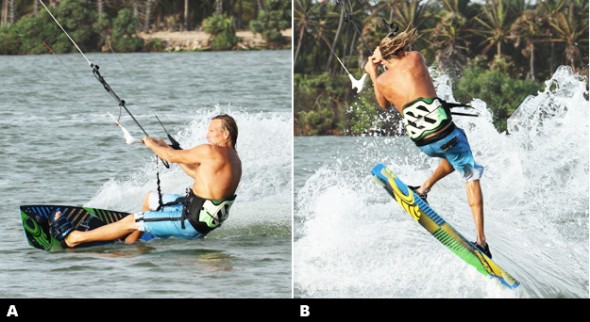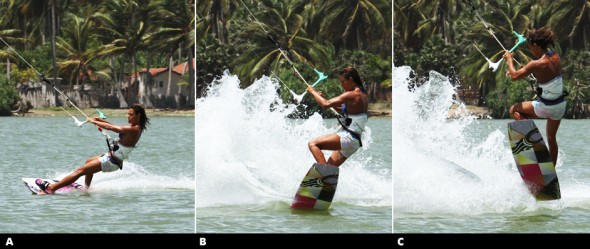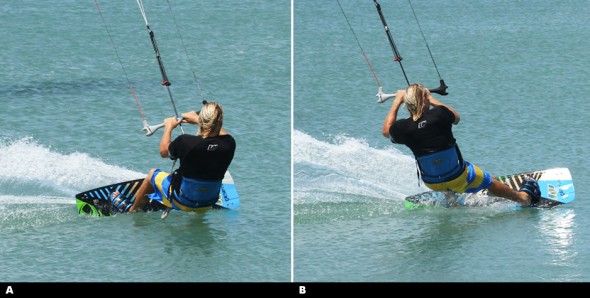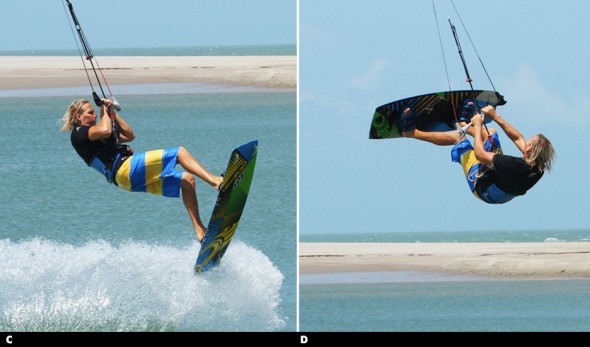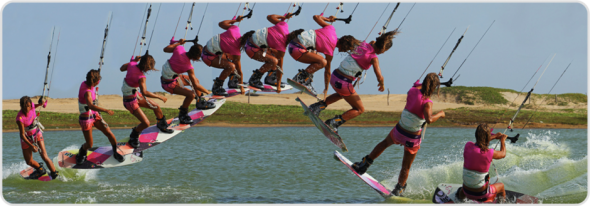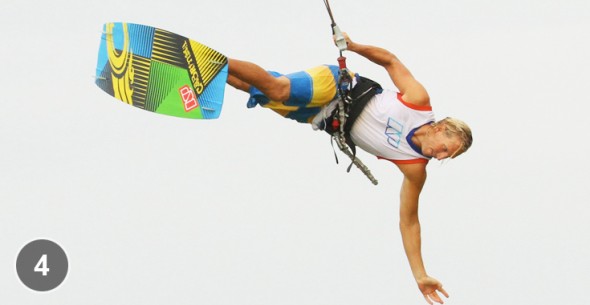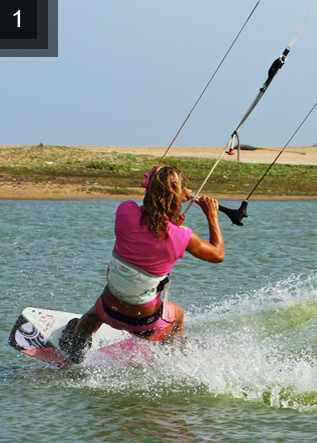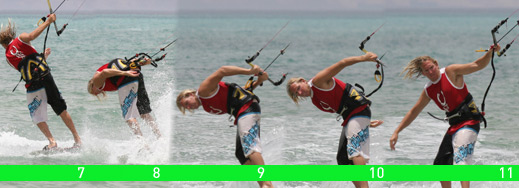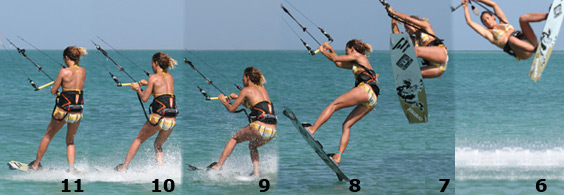Front Loop to Wrapped
Front Loop to Wrapped
This is a blind move for any aspiring freestylers. The “Front Loop to Wrapped” is an attainable pop move for anyone landing Shifty to Wrapped, also doubles your way to get into a non-inverted slim. Theoretically if you can perform a controlled unhooked front to toeside, then this move is just your step away.
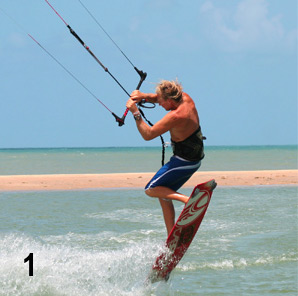 Pic 1 – From a front loop to toeside, you can see that the surfer has carved a long way upwind before popping. The result of this is that, regardless of how hard the fronts roll initiation it will have a stalling rotational speed effect at the start for the surfer to pop up into the rotation if needed. In short the surfer’s hands, bar and even the board are the way to a 360 degree rotation.
Pic 1 – From a front loop to toeside, you can see that the surfer has carved a long way upwind before popping. The result of this is that, regardless of how hard the fronts roll initiation it will have a stalling rotational speed effect at the start for the surfer to pop up into the rotation if needed. In short the surfer’s hands, bar and even the board are the way to a 360 degree rotation.
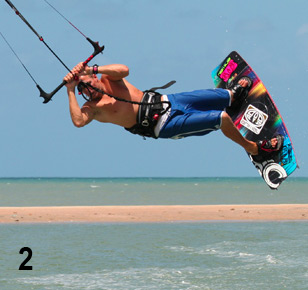 Pic 2 – You can see that the surfer’s head and shoulders have all but completed rotation. The legs however are trapped in a time warp and are following some way behind. The point here is to forget your legs and as long as you are ready for the landing with your head and shoulders, the board will drop down toeside.
Pic 2 – You can see that the surfer’s head and shoulders have all but completed rotation. The legs however are trapped in a time warp and are following some way behind. The point here is to forget your legs and as long as you are ready for the landing with your head and shoulders, the board will drop down toeside.
Building Blocks
Approach
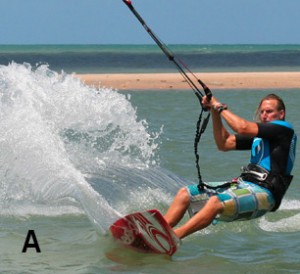 Pic A – This should be a familiar scene for many of you, as we are the usual ingredients for good unhooked pop. The surfer has the kite parked somewhere 10:30 and 11:00 o’clock and carving hard upwind with the bum low, shoulders, back and arms are bent slightly. The bent arms are is a must to do this trick. The surfer’s front leg are pretty extended with hips over the back foot and back leg resisting for preparation to pop off once carving into the wind is applicable.
Pic A – This should be a familiar scene for many of you, as we are the usual ingredients for good unhooked pop. The surfer has the kite parked somewhere 10:30 and 11:00 o’clock and carving hard upwind with the bum low, shoulders, back and arms are bent slightly. The bent arms are is a must to do this trick. The surfer’s front leg are pretty extended with hips over the back foot and back leg resisting for preparation to pop off once carving into the wind is applicable.
Take-Off
Pic B – During the take-off you need to keep your arms in close. Popping up will make this a lot easier. You will also need to get the kite where it should be as the chances are it will rise slightly during your carving stage. Here you can see the surfer has popped up hard off using the back leg with hands close to the bar. The surfer has also steered the kite down a little by pulling on using front hand, which also helps the initiation of the rotation combined with dropped front shoulder at the same time to turn swiftly.
Waiting
Pic C – This picture sums the move up and also demonstrates the similarity between a shifty to wrapped, shifty 3 and the front to wrapped. With the rotation on going, the surfer focused on where to land while feet are catching up but still behind position. The objective here is to wait until you feel that your feet are dropping down because that is the sign to go for the wrapped. Timing is very important.
The Pull
Pic D – As mentioned, you’re the dropping of your leg is the signal to go for wrapped. The reason is you will be using the momentum of your dropping legs to bring them through and up to turn to a wrapped. Once they start to fall – use them!
The surfer here has reaction to the legs because of both hand pulling hard and aiming to go past the right hip while bringing the back (right) leg up towards the bar. If the kite is too high, the lift will make the landing and passing difficult. When pulling on the hands, it is a good idea to give the kite a little tweak down because it can make the rest of the move much easier. As soon as the surfer’s back knee comes up, other knee is bent, turn head with the rotation and let go with front hand, thus allowing the surfer to turn with the momentum on going.
The Landing
Pic E – Your aim is to get the board at least downwind but preferably a bit further around, so that you will keep your speed and move towards the kite to make the pass out of wrapped much easier. Continue to turn your head to look where you should be going. In the picture, the surfer almost has too much weight back, which can lead to bouncing on landing. As you come down, even though you released your front hand, you should carry on pulling the bar behind your back with your back hand and twist your wrist. This will place the bar correctly, and it will wait obediently for the pass.

Step by Step Sequence Summary
1. The surfer bears off the wind considerably, unhooks, drops weight and starts to carve into the wind.
2. The surfer aims to carve a long way up into the wind and keeps the hands in close.
3. As the kite starts to pull, the surfer pops up hard by extending back leg with all might while pulling hands down towards the body.
4. The surfer initiates the rotation by throwing front shoulder down towards the water and at the same time dips the kite by tweaking it with front hand.
5. In this position, the surfer can now rotate the head around, looking back over the trailing shoulder which will guarantee him enough rotation to get the way around the first loop.
6. With eyes focused on where to land, the surfer waits, timed, and doesn’t try to land quickly then he brings the legs around through the landing position.
7. As the legs start to drop, the surfer pulls hard on both hands, trying to rip the bar past the back hip, at the same time bringing the knees up towards the bar.
8. The surfer releases front hand and turns the head while keeping the knees up. Remember to twist as this will make your body rotate much easier.
9. Coming in for the landing as you can see that the surfer has the bar and wrist turns and ready, he turns the head to try and look where to land giving weight forward over the board.
10. The surfer lands with the board facing slightly off the wind and the arms wrapped around behind.
11. All that’s left to do is to reach behind with your free hand and pass the bar. The further you rotate the quicker you will need to do this as you will have more tension on the lines and the kite will rise.

Tips to Remember
1. Edge hard upwind
2. Keep hands in
3. Pop up over your hands to rotate
4. Lead with head and shoulders
5. Pull both hand hard past your back hip
Air Gybe with Late Kite Loop
Air Gybe with Late Kite Loop
This technique is really much a cheat as it is a trick, and a very handy one. A late kite loop in this case means that the kite loops once you are on the water, not in the air. Perhaps you’ve already seen it many times before. The fact of the matter is when your kite control goes southward while altering direction in the air, doing this will provide you a nice bit of pull.
An upbeat outlook would predict several more advantages of combining this to the humble air gybes. It’ll give you the chance to hold them for longer and rack up the style points while still bursting with speed. On smaller kites, there is more chance of steering your kite too far behind and this yet against is a perfect answer. More retro pop transitions often result in you swinging away from the kite. Once more, this is the cure.
To cut it short, if you sometimes find your kite low and way to the side when you’re hoping to plane out of a transition, this trick will give you a handy boost of power right where and when you need it, and those days of sinking down will totally be gone. And finally, this can be an exceptionally comfortable way of building up yourself trust and skills in anticipation of a winner kite loop. Warning though, if you have never voluntarily looped your kite, we would strongly suggest learning the under turn first.
BIG POINTERS
As with any attempt to air gybe, it will still benefit you to try and get the basics right and add the late kite loop onto the end rather than try to apparently fluff it. We will be repeating ourselves to save you looking elsewhere.
Pic A.
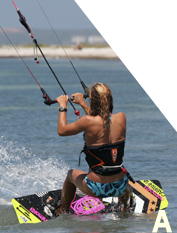 The surfer is about to take off and has approached with speed and kite not lower than 1 o’clock. To drop speed, you need to carve into the wind by putting weight over the rear foot, moving the hips towards the tail of the board and extending the front leg. The straight front leg keeps the board on its edge. The surfer has already steered the kite back aggressively and has the bar pulled into the spot where here back lines are tight. From this state, you can jump up off the back leg into the air gybe.
The surfer is about to take off and has approached with speed and kite not lower than 1 o’clock. To drop speed, you need to carve into the wind by putting weight over the rear foot, moving the hips towards the tail of the board and extending the front leg. The straight front leg keeps the board on its edge. The surfer has already steered the kite back aggressively and has the bar pulled into the spot where here back lines are tight. From this state, you can jump up off the back leg into the air gybe.
Pic B.
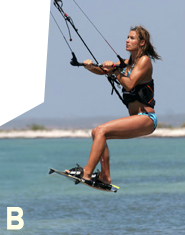 Now the surfer illustrates dropping back down towards the spot landing. You must be well balanced in this position. Have the board pointed off downwind by pushing your new front foot away while keeping the rear foot underneath. You need also to dive the kite hard to get it moving down in front rather than letting it drift slowly to the side. This way, it will pull you out of your free fall and get on moving as soon after landing.
Now the surfer illustrates dropping back down towards the spot landing. You must be well balanced in this position. Have the board pointed off downwind by pushing your new front foot away while keeping the rear foot underneath. You need also to dive the kite hard to get it moving down in front rather than letting it drift slowly to the side. This way, it will pull you out of your free fall and get on moving as soon after landing.
Pic C.
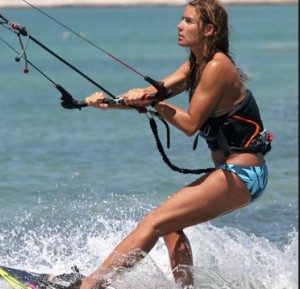 However, this is where it all changes from a regular air gybe to one with a late kite loop. Normally, assuming that you had dived the kite enough to ride away as soon as you land, you would be pulling hard on your new back hand in an effort to stall your kite crashing straight down into the water and turn it back up. Rather than steering the kite back up, continue to pull with the front hand, in fact pull even harder. This means that the kite keeps turning under itself and does not hit the water. As long as you keep pulling, the kite will start to rise and then turn forward in the desired path. To make this fun, keep the bar pulled in so that the kite continues to turn. Keep the board pointing off the wind and keep your weight back over the tail of the board.
However, this is where it all changes from a regular air gybe to one with a late kite loop. Normally, assuming that you had dived the kite enough to ride away as soon as you land, you would be pulling hard on your new back hand in an effort to stall your kite crashing straight down into the water and turn it back up. Rather than steering the kite back up, continue to pull with the front hand, in fact pull even harder. This means that the kite keeps turning under itself and does not hit the water. As long as you keep pulling, the kite will start to rise and then turn forward in the desired path. To make this fun, keep the bar pulled in so that the kite continues to turn. Keep the board pointing off the wind and keep your weight back over the tail of the board.
If you have another look at the video, you’ll see that the kite is diving straight down as if the surfer was landing an air gybe, but upon touching down, the kite goes under and around by pulling it a bit strong, dragging the surfer nicely along to the left side.
THE GREEN LIGHT
Once you’ve decided to do this, there are a few good ways of getting you warmed up. Firstly, practice a couple of under turns. If you’ll be going for this air gybing on your right, do the under turns on your left and vice versa. Now, you’ll be confident enough that the kite will go around.
Secondly, knock off a few air gybes and focus on diving the kite hard for your landing. If this feels comfortable, try watching your kite as it dives down. So basically, turning it one way or the other shouldn’t make any difference.
SEQUENCE 1
In these images, the surfer is using a 7m Nomad, which turns fairly quickly but won’t give her a massive amount of hang time. The surfer has the advantage of a kite that will loop with only a little positive input on the bar. But the disadvantage is that, the preparation for landing in a big chill position is cut short.
1. Making sure that there is no one at the back and could have more space to party. The surfer carves hard into the wind and sends the kite back. Weight back, front leg straight and bar close in.
2. As the surfer feels the kite starts to lift up, the next thing to do is to stop steering the kite back and places the bar at center parallel to the water. Still keeping the bar close in
3. The surfer then explodes up off the rear leg rather than waits for the kite to pull up, and pulls the bar right in – hands to hips.
4-7. Upon take off, the surfer tries to get the kite back above at 12 o’clock by keeping the bar level and keeping the tension on the lines by keeping both hands close and arms bent. Also the surfer starts to lift both knees up for stability. Now, it’s the big chill – keep this position up until the tip of your jump and wait until you drop.
SEQUENCE 2
1. As soon as the surfer feels like dropping, the surfer dives the kite hard with the new front hand, the left hand.
2. To make sure to have full control over the kite, the surfer keeps the bar in close, and thus has tension on the lines, so the kite will react whenever wanted/needed.
3. In readying for the landing, the surfer pushes the front leg forward and keeps the rear leg underneath. The scissoring of the board will point the board downwind. The surfer keeps sight on the kite as it wanted to be diving down.
4. Just before touching down, the surfer drops the legs to take the landing, the whole time the surfer has the bar pulled in and is still pulling on the front hand. Pulling off the can be of help to land downwind.
5. As the surfer lands, the board continues downwind. It would stop if you land on an edge, not ideal when the kite is about to generate more power. To compensate for any extra force, the surfer puts weight over the back and front leg extended.
6. Because the surfer has kept pulling, the kite has turned under itself and back up. Because the board is facing downwind, there is no abrupt pull, just a smooth acceleration out of the landing.
7. As the kite turns forward towards the new path, the surfer carves back onto the edge by pivoting the hips and shoulders further around to face which direction to go. The surfer also halts on pulling on the front hand, as another loop would be unnecessary.
USUAL PROBLEMS
There are several possible causes…
If you keep dumping the kite into the water while you land balanced and over the board.
- If you are not 100% committed to what you will be performing, looping the kite once you have landed, it is very tempting to let the bar out as soon as you feel a little pulling force from the kite, as it starts to turn under itself. Once you’ve released the tension from the back lines, even steering hard won’t keep the kite moving round. The answer is absolutely get some under turns and hard diving air gybe exits under your belt and then merge them up.
- You may not be actually steering the kite good enough. On larger kites, you may need to move what will be the new front hand towards the end of the bar to provide you the power to really pull the bar in.
- If you are landing with your kite unusually low to the water and to the side where you came from, and want to go back to it will not have enough room to turn under itself. The higher the kite starts the loop, the easier it will be.
If you find out that you are getting dragged off balance in the air.
- Chances are, rather than considering this as an air gybe, you’re more into super loop territory. Remember to get the kite back above you so that you’ll be in good terms with it at 12 o’clock. This way, the pull will come more from downwind and less likely from behind you.
- Timing is key. You need to be diving the kite at the same time you would for landing an air gybe just before touching down. If you pull too early, the kite will try and turn under itself while you are still up in the air, also known as kite loop which you can learn onto, but focus more on the late kite loop timely.
Lastly, if you are getting pulled onto your face when the kite loops, make sure you’re not edging against the pull AND put your weight back with your front leg extended.
KEY POINTS
- Edge then send
- Big chill
- Wait and dive just before landing
- Point board off wind, weight back
- Keep pulling with new front had
And the video…
Sent Back roll Nose Grab
This is very exciting and this is one of those many jumping moves that many of you learnt during your early steps and adding a glorious nose grab so that it doesn’t look in the slightest stale. In fact may get many of your peers back on the back roll bandwagon. Obviously all grabs are great but a nose grab really stands out as it forces you into a tweak, which just oozes style and smile. Only prerequisite for this is a sent back roll, but if you’ve already got the nose grab jump dialed, things will be very easier for you.
The Jump Pic A
To grab the nose whilst back rolling you’ll need time, and for time read slow back loop rotation. The only way to pull off a fancy slow roll is to get enough height, so the jump is everything. Approach wise you should be coming in on a good edge with the kite either at 11 or 1 o’clock, no higher. Extend your front leg to push your hips back on the board, essential for a controlled back rotation, and even though this will bend your back leg, keep it solid not soft; otherwise you won’t be able to hold the edge against the kite’s pull.
In Pic A the rider’s front leg is straight and her back leg is locked to maintain a solid edge and her derriere is low. With her kite moved into position and her but in the sweet spot she can now send the kite as for a jump and concentrate on resisting the resultant pull and lift with her back leg.
The Initiation Pic B
The way you start your back roll will dictate the entire rotation, so bearing that in mind let’s have a look at when and how the rider get’s things under way. Having resisted with a good edge whilst sending the kite quite hard from 11 o’clock the pull should come early, at about 12 or just after .  As soon as the rider feels the pull she stamps up off her back leg in a popping motion and then pulls the bar in. By popping up into the back loop she can’t lean too far back or bend both legs and therefore can’t carve too hard into wind under the kite, so her rotation will be slower. This is because she is taking off upwind, not already into wind, so she has further to rotate in the air. And by pulling the bar in the rider can immediately freeze the kite above her, preventing it from continuing back as is often the way in sent back rolls. Note that although the rider has carved into this rotation she has not thrown her head over her front shoulder. You want slow and controlled so keep your head looking forward.
As soon as the rider feels the pull she stamps up off her back leg in a popping motion and then pulls the bar in. By popping up into the back loop she can’t lean too far back or bend both legs and therefore can’t carve too hard into wind under the kite, so her rotation will be slower. This is because she is taking off upwind, not already into wind, so she has further to rotate in the air. And by pulling the bar in the rider can immediately freeze the kite above her, preventing it from continuing back as is often the way in sent back rolls. Note that although the rider has carved into this rotation she has not thrown her head over her front shoulder. You want slow and controlled so keep your head looking forward.
Go Early Pic C
It’s the same for pretty much every grab, you have to go for the grab straight off the bat, the longer you wait the less time you’ll have and the less likely you’ll think it’s a good idea, especially when it involves:: bit of stretching and twisting. You can clearly see another advantage of not throwing your head into the rotation. As the rider gets airborne, by looking forward she is actually staring right at the board. This way she can see where she will grab and can prepare for it. The rider lifts her front knee up and across her body, knee towards opposite shoulder and releases her back hand and reaches it down towards the nose – all the while keeping the bar in with her front hand.
This is a beauty, and by jove does it suit a back roll. Once you’ve got the nose or toe side edge up front, do actually grab it firmly as it’ll help you pull your front leg in and give you something to push against with the back leg, leading to a wonderful tweak, which you can hold for as long as you dare. Looking at the grab keeps your head between your shoulders, so will keep you rotating slowly.
This is probably a good moment to mention the advantage of giving the kite a decent send for the jump. It’s not just about getting height, but because you’ll spend a considerable amount of time keeping the bar pulled in with only your front hand, the kite will merely move from behind you to slightly in front of you. If you gingerly drift the kite up, by the time you come around your back roll the kite will be way too for forward and pulling you off balance.
The Finish Pic E
If your rotation is controlled and the kite is not too for forward you can hold the grab until just before touchdown.  However looking at your grab and the front of the board will not encourage you to finish off the rotation. To make sure that you complete the 360° and get far enough around landing perfectly you will eventually need to turn your head over your front shoulder to see where you’re going, spot your landing and get the board pointing downwind. When you do release the grab, only release the grab – so keep your knees up and the bar in so that you can dive the kite for landing.
However looking at your grab and the front of the board will not encourage you to finish off the rotation. To make sure that you complete the 360° and get far enough around landing perfectly you will eventually need to turn your head over your front shoulder to see where you’re going, spot your landing and get the board pointing downwind. When you do release the grab, only release the grab – so keep your knees up and the bar in so that you can dive the kite for landing.
Top Tips
- Keeping in line with practicalities do start with some back rolls, concentrating on the send, upward take off and slow rotation.
- Then start to bring your front knee up and across whilst keeping your back leg bent. Once you’re happy with this release the front hand and go for the early grab, which you can hold or touch for just a fraction of a second. Finally build up to a long tweaked hold.
- Trim your bar and sweet spot in a touch, as it’ll make reaching the shoulder across for the grab more comfortable. And keep your harness tight!
Common Problems
- If you are over-rotating your back roll and either landing across the wind on an edge or starting another rotation make sure that you don’t carve up excessively during your take off.
- You should go from the edge that you’ve approached with, and then kick up and around. Also make sure you dive the kite for the landing as this will stop your rotation and pull you off down wind. If you can’t reach the grab, try a few without a back roll.
- The nose grab is more about bringing your knee up and across under your harness hook, rather than you reaching down for it.
- If you’re getting pulled forward and off balance by the kite in the air, either crashing or landing nose first. This is a result of the kite flying forward of
- 12 o’clock, so in the rider’s case towards 11, and can be due to a number of reasons. Firstly make sure your hands are centered on the bar, keep the bar in with one hand without yanking it forward. Make sure you send the kite, the further it goes back, the further it needs to return, so there is a perfect balance depending on your height and kite size.
Keystones
- Good solid edge with legs resisting
- Send kite positively
- Pop up into the back roll (not around)
- Pull front knee up for early grab
- Turn head to complete rotation
Popped Hooked Front Crail /Nose Grab
Making your move look good is an art and result of regular practice. The best key is whatever you do, do it with right way and follow instruction from professionals. Every professional kite rider has his experiences to share and valuable tips for new joiners. An amazing enthusiast this sport is and with that in mind here is our guide to a popped front roll with a Crail or Nose grab thrown into the mix for extra spice. The grab itself is done with the back hand reaching forward and touching, stroking or preferably holding either the nose of the board or as near as possible on the toe side way up near the fin. It goes without saying that you’ll already need a competent popped front to nail this beauty, as the more powered it is performed with, the better the axis of rotation will be and thus all the sweeter the grab will look. Let us remind you of a few vital key moments for a decent popped front whilst also sneaking in the grab.
Coming In
If you want pop you need to approach in the right way, as it will not only aid in getting up and off the water, but also the rotation and the landing.
In Pic A. the rider is perfectly set up for some hefty pop. With her kite parked just below 11 o’clock she pushes the nose of the board off the wind and flexes her back leg to flatten the board, increase speed and move towards the kite, allowing it to drop back a bit in the window. At the sometime she has all her weight, hips, head and shoulders dropped back over and behind the back foot. Her hands are centered and she has her bar trimmed in enough that she can get into this position without pulling too much tension onto the back lines. It is advisable to move your front hand over the middle of the bar, center line between your first two fingers if you can. This will allow you to keep the power on throughout the move without the kite diving down.
Take Off
Going into a popped front rotation it is all too tempting to drift the kite up and wait for something to happen, which will inevitably lead to a dangly and uncontrolled spin under a very high kite. It’s a most to keep the kite flying forward and get your height from a very aggressive pop. Breaking the pop and rotation apart, even just by a millisecond will make all the difference. If you concentrate on going up before throwing your head around and shoulders down you will get enough height. If you dive straight into the rotation you’ll not extend up and rather fire yourself down towards the water.
Pic B. shows the rider popping up hard. Having carved quickly back up onto her edge with her weight still back, she has now stamped down hard, pushing her back leg down against the edge of her board and extending her body upwards for maximum pop. She keeps her front elbow tucked in and bent to prevent the kite from drifting up and the bar is still angled towards the kite as if she were riding. The only give away showing a prospective front rotation is the bending and lifting of the front knee.
Rotate and Release
Once you know that you’re on the way up you need to get spinning and think about the grab. You won’t have long in the air so its chop chop. To initiate the rotation lean the head and shoulders forward, so that you are going with the pop. By lifting the front leg and allowing your body to be kicked up you will start to rotate from the back legs impetus. Turning your head to guarantee spin will help, but if you whip around too quickly it’ll be tricky to get the grab in early enough. As for the grab you need two actions, release the front hand and start to reach forwards, and you must bring the front knee up and across your body to bring the nose of the board within reach.
Pic C. the rider is just off the water and she already has her front knee up and across in front of her. She resists the temptation to pull her back leg up and keeps it straight – with it extended the nose of the board will tip even closer to her.
She allows her head and shoulders to tip down and forward into the rotation as she fully extends up and keeps the bar pulled in. Her back hand is reaching down towards the already well-positioned board.
The Grab Getting the grab in early has two advantages. The first is purely aesthetic, you’ll be able to hold it for longer and thus it’ll be more noticeable. The second however is more functional – once you have the grab you can pull the board in, making you small and then concentrate on getting around the rest of your front roll. Theoretically at least, if you get the take off right the grab should fall into place.
Pic D. As a result of all the hard work the rider has got a pleasantly satisfying pop, good height and controllable slow rotation. This allows her to get her hand onto the nose area before she has rotated 90°. Keeping the front knee up and releasing the back hand early were key. Keeping the bar in and power on guarantee that she won’t just drop out of her rotation, but will continue to be pulled forward. The Money Shot Once you’ve got the grab, hold it. As stated before, this isn’t just for poseur status, massaging your ego or blatant show boating, but with a solid hold of your board you can pull it in and turn your head and therefore finish your rotation.
Keeping the bar in and power on guarantee that she won’t just drop out of her rotation, but will continue to be pulled forward. The Money Shot Once you’ve got the grab, hold it. As stated before, this isn’t just for poseur status, massaging your ego or blatant show boating, but with a solid hold of your board you can pull it in and turn your head and therefore finish your rotation.
Pic E. With her grab held the rider turns her head to spot the landing. To speed up her rotation she has pulled both knees up whilst still holding the bar in, keeping the kite moving forward and pulling.
Touch Down
Aim to hold your grab for as long as possible, until you complete the rotation. You’ll find the timing quite natural, as you’ll need to let go to allow your board to drop under you as you start to drop. Assuming you went off the wind in your approach you should come around to a comfortable downwind landing towards the kite, which will kill the power in the kite and make tutu comfortable stomped landing.
Pic F. You can see that the rider has released the grab and lets her legs and the board drop down beneath her for a solid reception. She still has the pulled in so will land following the kite with her weight squarely over the board.
Top Tips
- A good pop and confident front roll are key, so before throwing yourself up into one of these get warmed and ready with a few two handed front rolls.
- When you’ve knocked out a few high and controlled ones you’ll be more confident to go for the grab.
Common Problems
- If you’re struggling to reach the grab there are two solutions. Firstly if you can already nose or nearly nose (troll) grab the board in sent jumps or front rolls try popping with the kite higher, or even drift it up a tad.
- With a higher kite and a more vertical rotation it will be easier to reach the board. Secondly if you’ve never tried a two grab before and you’re finding it tricky here, revert to getting the body movement right in a sent jump and then a sent front roll.
Keystones
- Bear away with weight back for god pop
- Extend up fully
- THEN release back hand and start rotation
- Bring front knee up and across
- Hold grab and turn head
Front Roll Hand Wash Transition
Yes another hand wash. These moves are always popular crowd pleasures and on clinics everyone wants to get involved in some water tickling. This is the front roll or front loop variant and it has its roots firmly placed in the more traditional popped front loop nose grab transition from yesteryear as featured in Issue 31! There is quite a lot going on in a short amount of time, so you’ll not have the luxury or hindrance to worry about flying the kite, it’s more pop and go and until you’ve nailed a few the kite will seemingly dictate when everything happens. This is another move that will be far easier to learn on a bigger kite and much trickier on a 7m.
Your approach into this is similar to that of a dark slide or back roll hand wash if you already have those nailed. If not fret not, your principal aim is to stay low whilst maintaining your edge. Normally to pop we explode upwards and naturally as you sit you will bend your knees and come up over the board. So get your cheeks down low whilst keeping your edge. This way you’ll have an edge to kick up and off, whilst being low enough to get your hand in the water.
You can see the rider approaching with his kite about 11 o’clock, bar trimmed out so that he can keep tension on the lines with an extended arm, plenty of speed and he is sitting low but still with plenty of edge. From here the rider takes his front hand off the bar, turns further into wind to check his speed and very gently pulls the bar in with his centered back hand.
Kick Edge Pic B.
Timing wise your moment to go is the same in all these pop trick transitions, you must go early, that is to say before you feel the kite lift. As long as you pre-empt the lift your kite is less likely to fly too far back in the window and you’ll be able to stay low.
In Pic B. The rider really kicking off and against his edge, not up. This fortunately is the standard kick off fees forward rotation but here you must exaggerate the action. The rider leans forward and stretches his free front arm out in front of him as he kicks. This will both initiate the front roll and plant his hand into the water. It is important to get your hand out in front as you’ll soon overtake it without the resistance and drag it’ll produce once buried in the water.
Hand Plant Front Roll Pic C
Not a delicious Ionian snack but your next port of call. If you get your hand down on a straight and stiff arm you will rotate no matter what, as your hand becomes the axis for your rotation. This means that you can try and concentrate your efforts on your kite or rather your other hand, the one holding the bar. You need to keep tension on the lines by holding the bar in on the sweet spot, whilst trying your best not to send the kite steaming off behind you. Three things will help: hand in the centre of the bar, sweet spot trimmed out and big kite…
Here in Pic C. you can see that the rider kite has still not reached 12 o’clock and he is already well into the move. He has his hand in the water and is making an effort to resist by keeping his arm locked out. Simultaneously the rider keeps the bar in and as such the kite will be slowly drifting back whist The rider pendulums underneath.
Upside Down Pic D.
As mentioned earlier there is an element of just going with this move as you learn it. However if you can you should try and invert yourself as much as possible to get some extra style points. You’ll see some folk banging these moves out totally straight and stiff. As your head is down it is a matter of getting your hips, feet and board up, and the simplest method is to keep your hand firmly planted and straighten your legs. With the drag from your hand they’ll be forced up! You can see that the rider pushing his feet up in an attempt to get inverted. Worth noting though is that his hand is only just in contact with the water so he is about to lose resistance and his opportunity to get fully upside down. Whilst trying to straighten up the rider has to keep the bar in and be ready for the moment that he gets lifted and his hand releases from the water.
Is Dive & Land Pic E.
Once you feel yourself lifted, this is your cue to finish your front rotation as the kite has passed through 12 and is effectively jumping you up off the water. If you can get yourself around, then you’ll be able to see where you’re likely to land and balance yourself against any awkward pull from the kite.
Looking at Pic E. you can see that the first two things that the rider has done are allow his legs to drop and get his free hand back on the bar, as both these movements will give him more control of the situation. By dropping his feet the rider has his undercarriage and landing gear down, and with two hands on the bar he can better control how quickly the kite is moving. The rider is also looking back and down wind, so that he can turn his body and board to where he should be landing. What he does now will depend on how far back the kite is and how far out the rider has pendulum. If the kite is still relatively high the rider will dive hard with his new front hand (the right one) to pull himself out of the move. If the kite is quite far behind the rider will have to dive it harder, aiming for a late kite loop, so that he’ll have the power to keep moving once he lands. Whilst learning this we recommend that you go for the first diving option, as it’s better to get wet and water start than get thrown around backwards.
Top Tips
- It’s a good idea to start off with some gentle popped front loop transitions with both hands on the bar to ease you into the kite timing and see how far back the kite goes.
- If it is going a long way back go earlier.
- Once you feel confident get low and give it a go, not much can go wrong as you shouldn’t be more than an arm’s length off the water.
Common Problems
- Main problem that you’ll have is the kite ending up too far behind you, so go early and keep your edge whilst you get low, and let the bar out a bit to stop the kite drifting too much.
- You may also have trouble getting the hand in and keeping it planted in the water. Really reach forward and throw yourself down into the water.
- Once it’s in resist the pull against it. This may take a few goes to get your head around.
Keystones
- Get low but keep your edge
- Release your front hand and kick forward early
- Reach your hand forward and down into the water
- Resist and try to straighten your legs up
- As you lift drop legs and turn to dive
Front Loop Grab
It was recently brought to our attention that we had yet to cover one of the first and potentially simpler of front loop (or front roll) variations – the grabbed sent front loop. We’ve talked you through the inversion, the one foot and all manner of transitions and pops, but this issue we’ll set the record straight and deliver an achievable and yet utterly stylish grab which you can add on to your much loved front loop. Adding a grab onto any move that you already have in the bag is a matter of both confidence and making sure that you have the basics right, so we’ll have a look at what is needed to secure a comfortable and safe front rotation whilst enabling the back hand to come off the bar and grab the board.
The set up and take off – Pit A.
To learn this, you’ll best keep everything as close to your standard default front as possible, so that you’re adding a grab, not learning a new move. However there are a few points in the set up that you’d do well to follow and we’ll look at the rider as an example. Firstly if you don’t already, you should centre your hands on the bar, so they are resting either side of the centre line. This will stop any unwanted movement of the kite when you grab. With your hands together, sending the kite may seem a little sluggish so be sure to use both hands in a push and pull movement.
Secondly don’t be afraid to send the kite as hard as you normally do. If the kite travels past and behind 12 o’clock, then pulling and supporting yourself on the bar with your front hand won’t result in an immediate diving of the kite.  Thirdly do trim the bar at least down to half way, as this way you are less likely to stall the kite on takeoff and during flight, which hopefully means that you’ll execute an up and down jump rather than flying downwind at speed.
Thirdly do trim the bar at least down to half way, as this way you are less likely to stall the kite on takeoff and during flight, which hopefully means that you’ll execute an up and down jump rather than flying downwind at speed.
Finally, although you must complete your rotation, it will be easier to grab if you’re not spinning too quickly. So to slow your rotation down just a tad doesn’t use your head to turn you on takeoff but rather just your shoulders and the kick off. You can see the rider is still looking forward as she begins to throw her shoulders down towards the nose of the board and stamp away against her back foot edge.
Grab Prep – Pic B.
The secret to getting a grab in during the short time you have is to go for it early. Looking at the picture you can see that the rider is wasting no time in releasing her back hand and lifting the back of the board up towards her as soon as she takes off. You can also see that The rider is looking towards the tail of the board where she intends to grab it, so she can cirri her hand at the target and bring hand and board together. This would not be possible if she had thrown her head around to look over her back shoulder in order to get the rotation. Having released her back hand so early she can already pull on her front hand a little bit, so long as she did send the kite back past 12 O’clock. In this jump the rider is aiming for a boned out grab, hence she just lifts her back leg, but you’re quite welcome to lift both knees if it feels more stable.
The Grab – Pic C.
The moment of truth! Your easiest and most reachable options for the grab are either the heel side edge by the fin, or the tail itself. It’s a great idea to practice this on the beach without your kite to find out where is most natural for you. Holding a grab, rather than a little tickle is a good game plan, as you’ll have more balance with both hands occupied, so literally grab the board and pull it towards you. Once again to bone it out you can straighten the front leg by pushing your front foot away from you whilst holding the tail in close. In the picture you can see that The rider is still watching her grab, which keeps her rotation slow, and she has the bar held in, which keeps tension on the lines and the kite under control as it gently moves it above her.
If you’ve held the grab and controlled your rotation speed from the take off you will need to initiate and prepare for the landing by completing your rotation. The first and most important ingredient is your head. The rider has turned her head to look around towards where she will land. The old adage of where you look is where you’ll go has never been more true. As your head turns your shoulders will follow, and as long as at least one of your knees is held up so will your hips and board. With your body turning towards the expected landing strip you need to maintain tension in the lines so that you have enough float to get around, and as you can see The rider still has her bar pulled is From this point onwards as you drop slowly down the harder you pull on your front hand, the more the kite will pull you downwind toward a soft landing. Our suggestion here would be to release the grab and get both hands on the bar so that you’re confident with the dive and can then control the power on landing. As you drop the grab, allow your legs to straighten underneath you so that your landing gear is down and that you have a platform to land on. If you keep your knees up, you’ll land with the board in front of you, not underneath you and you’ll be unlikely to smoothly sail off downwind. And if you have boned out the grab remember to lift the front leg slightly as a tail first landing will be a lot more pleasant than a nosedive.
Top Tips
- As already mentioned playing with the grab on land, whether rolling around on the beach, your lawn or in the lounge will train you to grab without too much thought.
- Once you’re on the water start off by throwing down a few front loops without the grab so grab as soon as you take off – if you wait you’ll miss Now check out the sequence and videos – good luck’ that you’re feeling confident.
- Your next step is to go the moment. For a quick tap of the board and then finally hold the grab.
Common Problems
- If you’re struggling to find the time to grab, your rotation is too fast.
- Practice some front loops, still using your rear leg to kick off and your shoulders to dip forward but keep your head perpendicular to your shoulders – this should help. Also go for the
Keystones
- Good edge and positive send
- Kick hard but don’t turn head
- Go for grab early, immediately after take off
- Tom head to complete rotation
- Drop legs and dive to land
Inverted Grabbed Front Loop
Funnily enough some of the most pleasant to watch and pleasing on the eye kiters are not necessarily the most radical, but simply the most stylish. Obviously there are the golden few who combine both and have as a result forged a decent career out of kite surfing. So with that in mind here’s another way of adding the mustard onto a move that you can already do, the glorious front loop. For this very reason we won’t be delving into the finer details of the front loop, as we’ll assume that you have them dialed, but rather concentrate on the required aspects of pimping your FL, polishing and adding to the bits that matter.
The Take Off
Your approach and take off should be as normal. Coming into the front loop you’ll need to be thinking ahead so it’s best not to change the way you get off the water, but for one thing…
In Pic A. the rider has already committed to her forward rotation as per normal, she’s sent the kite and kicked off her back foot to push into the rotation and has the bar in with tension on the lines to control the kite throughout the move. The important exaggeration is in her head movement. In an effort to create a more inverted rotation the rider has really thrown her head forwards towards the nose of the board. This will rock her weight and centre of gravity forward of her harness hook and literally tip her upper body forwards, lifting the board behind her.
This is in preference to turning her head back and spinning under the kite and around her lines. Also note that her bar is close to her and her hands are not above her. If your arms are straight and the bar is above you, you won’t be able to throw your weight forwards. The resultant tipping from your head on your front shoulder will give a more horizontal body rotation, but not an inverted one – for that we need more. On the way up get the kite close to 12 o’clock so that it is in position for the rest of the move.
Arch de Triumph
Getting your feet up once again relies on some head work. This is potentially the most confusing and disorientating part of the move, as it is very different from what you will have done before.
Pic B. Once the rider feels that she is rotating and has brought her knees up towards her body she initiates phase two of the inversion, most likely just before the 180° mark. To get the extra purchase on the inversion the rider now throws her head back, as if she were trying to see the water underneath her, in a back arching type of movement. It’s very important at this time to keep the bar in and tension on the lines, as you will need to apply some pressure through your hands to help. With her head on the way back and down, the rider’s knees, feet and board will rise further.
It is at this point in a front loop that you would most likely turn your head further to see where you are going, and it will take some concentration to override your muscle memory! Also as you throw your head back don’t be tempted to correct the kite, as strangely once you’re upside down you may well get confused as to which is your front hand. Not to worry though as the grab will sort that bit out.
Show Your Board
Pic C. As soon as the rider threw her head back she released her back hand and went for the tail grab . From this moment on you are committed. Holding the grab the rider has pushed and extended her legs to get the board up. By pushing her feet away whilst holding the grab with her back hand the rider is able to “bone” the grab out. You can see that the rider is looking up at her back foot, but with her head still back.
. From this moment on you are committed. Holding the grab the rider has pushed and extended her legs to get the board up. By pushing her feet away whilst holding the grab with her back hand the rider is able to “bone” the grab out. You can see that the rider is looking up at her back foot, but with her head still back.
The good news is that because you throw your head back rather than look for your landing it should slow your rotation down so that you can hold the grab and inversion for longer. Do beware though that if you’re on a small kite, whilst you freeze in this pose the kite might well start to move forward and pull you downwind.
Coming Down
At first you’ll most likely prefer to come down the right way up, upright, and set up for your landing.
Pic D. To get the board down and her head up, the rider uses gravity.
 Simply by lifting her head, moving her chin onto her chest, she rolls forward as the weight of the board pulls her feet down. With this new view the rider can focus on where she’s going to land and act accordingly. Here the rider holds her grab whilst diving the kite with her front hand for touchdown. However if you feel that you’ve already over cooked it on the front hand you may have to let the bar out to avoid a super fast reception.
Simply by lifting her head, moving her chin onto her chest, she rolls forward as the weight of the board pulls her feet down. With this new view the rider can focus on where she’s going to land and act accordingly. Here the rider holds her grab whilst diving the kite with her front hand for touchdown. However if you feel that you’ve already over cooked it on the front hand you may have to let the bar out to avoid a super fast reception.
Once you’ve got this nailed and your confidence up, you can hold the inversion and grab for as long as you like, suddenly releasing and turning in time to land.
Top Tips
- For your first attempts just site it all down, be gentle and don’t jump too high. Ideally we’d recommend leaving the grab out and just concentrate on getting the board up. It’s stunning how going upside down can and will disorientate you.
- If you get it wrong taking it easy there’ll be no consequence. However once you have the movements and develop some special awareness we’d recommend sending the kite well on takeoff for two reasons.
- With a front loop you are likely to release the edge early and therefore need the extra oomph to get the height. Secondly as you’ll be hanging off your front hand whilst you grab with the other, with the kite further back to start with you are less likely to overdo it and come in lit.
Following Sequence 1.
Pic 1. The rider approaches with her kite at 11 o’clock, good speed, hands centered on the bar, a fine edge and the sends the kite as per front loop.
Pic 2. The rider kicks up and into her front loop off her back leg, but really concentrates on throwing her head forward towards the nose of the board to tip her forward into a more horizontal rotation.
Pic 3. As she leaves the water the rider brings her knees up, and gets the kite back up, with the bar held in to keep tension on the lines and aid with the inversion.
Pics 4 & 5. Coming around towards the 180 mark with the board rising the rider throws her head back, arching her back in an effort to get her feet above her.
Pic 6. With her feet up the rider releases her back hand and reaches for the tail grab.
Pics 7 & 8. Grabbing the board the rider pushes her feet up, extending her front leg to bone out the grab and get her sumptuous new board on display.
Pic 9. As she comes around the loop the rider drops the board down by lifting her head, so that gravity can take over and looks towards where she’ll land.
Pics 10 & 11. Releasing the grab on the way down the rider reaches up to get her back hand back on the bar.
Pics 12 & 13. With two hands on the be the rider dives the kite, drops her legs and sets up for a down wind landing.
Common Problems
- If you’re not getting enough inversion don’t look for the grab with your head, but rather lift the board with your legs until you can see it once you’ve thrown your head back. Remember to keep your bar in as you throw your head forward.
- If you’re under rotating and not completing the front loop, drop the grab and board sooner, and then turn your head hard to bring your shoulders around.
- If you’re landing with too much speed and the kite diving hard. Make sure that you send the kite enough, that your front hand is butted up to the chicken loop and that you’re not trying to pull yourself around the site front loop on your hand.
Keystones
- Bar in on take-off
- Throw head and weight forward
- Lift knees
- Throw head back and arch
- Push feet up
Beach Start From Two Feet
Many moons ago we covered the beach start where you anchor the board by putting one foot in a strap to stop it misbehaving and running off whilst you fly the kite. As effective a method as that may be, the launch can often be preceded by a game of hop scotch as you hop around on one leg waiting for the moment. Enter stage left the solution to a hopefully more dynamic and picturesque entry into the blue yonder, the beach starts from 2 feet. All the principals are much the same, bar the hopping, so let’s look at the ingredients separately.
1 Preparation Pic A.
How deep you need to start will depend on wind direction and space. Ideally you don’t want to be any deeper than just below the knee, with half way up your shin giving you a good balance between a soft landing if you get it wrong and an easy enough spring onto the board. We’d highly recommend not learning this in onshore conditions unless you have a lot of space down wind, and avoid rocky bottoms, sea urchins, mussel beds etc. and a crashing shore-break, you get the picture. We can see that the rider is carrying the board in her back hand whilst controlling the kite with her front hand. This way she can position the kite just behind her, in this case around 12.30 to 1 o’clock before she drops or places the board down, so that the kite is primed and she has the bar in with tension on the lines – this is your ready position and if you adopt it as you enter the shallows you’ll avoid all sorts of fifing around, swapping hands, repositioning the kite, dropping the board and generally getting out of shape as you rush to get ready. Also if there are waves, with the board in your back hand you are not in danger of getting hit by the board as the waves push against it.
2. Drop It Pic B.
Before dropping or placing the board on the water, make sure that you have your back into the wind, so that you know the wind is coming from directly behind you, as this will help get the board in the right place.
You can either drop or place the board in front of you. Dropping it has the benefit of being quicker and you can get the board further away from you. In the photo the rider has dropped the board in front of her so that it lands heel side edge first, which means that it’ll stay at the same angle whilst not stopping right in front of her. The board should lie across the wind, or ever so slightly up wind, but definitely not pointing off the wind. This means that you’ll have a solid platform to land on and the board will not be right next to you so that you’ll trip over it or fly past it whilst learning this if the board does skew off at the wrong angle you can push either the nose or tail to get it positioned correctly. However once you’ve got it sassed you’ll want this to be quick and dynamic.
Here the rider has already started to pull on the bar with her front hand to get the kite moving as soon as she has dropped the board. This way there is no time for the wind or is wave to move the board before she’s on it.
3. The Jump Pic C.
The idea is that you use the lift from the kite to float you up the few centimeters and support you whilst you slot your feet is You are not trying to launch yourself up and acrobatically land on the board from a great height. By moving the kite across the window from behind you, 1 o’clock to 11 o’clock, the principal is the same, but gentler than a water start – the kite will lift before pulling you forward. Now with two hands on the bar and tension on the lines, the rider keeps pulling forward and waits to feel the lift from her kite. As the kite lifts the rider pulls the bar in more and springs up with the emphasis being back foot up first, as this one should be the first to land on the board to keep the nose up. The whole time the rider is looking at her straps, so that she can aim her feet into them.
4. Contact Pic D.
When landing on the board, although the rider will get her back foot in first to stop the nose from sinking, she aims to keep her weigh central, as this way the kite will support her and keep her balanced. If she was to lean back against the kite or towards the back of the board she will slide the board away from her and dip her derriere in the water. You can clearly see that she has not gone for height, as she still needs to lift her knees to get her feet into the straps. As is result her feet, knees and board are in front of her and between her and the kite, so she can dive the kite with her front hand and use the pull to move forward and not get catapulted over the board.
5. Accelerate Pic E.
The final piece of the jigsaw is to casually ride away without sliding or tripping. For this you will need power, so as soon as you know/feel that your feet are in you will need to dive the kite harder from the previous lift stage. It’s almost two separate moves, the 1 to 11 movement to lift and support you, and then a dive from 1 to drive you out. To take this power you’ll need to drop your weight both upwind and back whilst pushing the board off the wind so that you can then carve onto your edge with power rather than sliding sideways with your weight on both feet.
You can see that the rider has dropped her weight low, moved her hips back over her back foot and pushed her front leg out so that the board can accelerate on is flat surface whilst her kite dives. Once she is balanced the rider will it’s her head, shoulders and hips to look Upwind and drive against her back foot to carve the board up onto its edge.
Top Tips
- The best way to learn this beach start is to break it into 2 parts, firstly the lift, spring and get your feet in. The emphasis here should be to land comfortably with both feet in the straps and the kite supporting you.
- Without the dive you’ll then drop slowly back into the water, and as you do you can dive the kite to pull you back up. Once you’re comfortable with this you can then anticipate the drop and dive the kite earlier and earlier until you exit dry and relatively powered.

Common Problems
- The most common mistake is to start with the kite too high. If you start with the kite at 12 o’clock, the power will not come on until the kite pulls low and forward. The result is to get pulled across the front of the board, whilst manically attempting to lean back against the power, so you’ll either catapult over the front or have the board tea tray out in front of you as you fly off the back.
- Remember you need the lift to support you getting on, and then the power to move off.
- If you are getting the lift but still seem to be sliding off the back of the board, it’s the result of the board pointing too far off the wind.
- And finally if you keep dropping back into the water, regardless of what you do, make a point of focusing on what your arms and harness do. Your arms are just for steering the kite, and your harness should be taking your weight. If you hold onto the power through the bar you’re both unable to steer the kite or sit back into the power.
Keystones
- Kite just behind you
- Bar in front hand, board in back hand
- Drop board across the wind, pull kite up and over
- Go up with lift, back foot first
- Once in dive hard
Twin Tip Duck Tack
A rather fun transition, the love child of two moves! You could look at it as the twin tip variant of the directional duck tack, but equally it is essentially an on-water, or un-aerial back loop transition. In its own right a smooth way of changing direction and a possible method of learning the key movements to the duck tack before venturing out on your surf or race board. Technically on a twin tip with straps, the mechanics of this move are not overly complicated, however the timing is crucial so once you get the movement, pasting it together piece by piece will deliver the goods. The end result should be a carve up and through the wind of almost 180° degrees, so that your board is across the wind with you facing upwind, followed by a pivot on the nose of the board to turn you and the board the remaining 180°, before you ride off back from whence you came – simples!
The Carve
You need to get the board a long way up into and through the wind so you’ll need some speed. However don’t come blotting into it like a bat out of hell, rather start on a good upwind edge, kite just above 11 or 1 and then momentarily sit down slightly so that your board flattens and picks up a little bit more. To be able to carve all that way you don’t need anything fighting you, whether it is the kite pulling you back downwind or the board dragging through the water. Therefore you need to get your weight, think hips and shoulders, more forward so that you use all the board to carve – the sitting slightly helps with this. If you’re low and have weight on both feet, the board won’t bog and drag, but instead whizz around. To go all the way you must get the kite up to 12 o’clock, so pull gently on your back hand as you approach. And finally to prevent the kite from holding you back you must let the bar out to get rid of the power as the kite moves up.
Pic A. The rider is carving into the wind whilst drifting the kite up to 12 o’clock with his back hand. He has taken his front hand off the bar, which allows him to twist his head and shoulders further upwind and let the bar out as the kite lifts. His front knee is slightly bent, and as he pushes his back foot away he breaks at the waist to keep his body upright. With weight on both feet you can see that his entire edge is in the water.
Half Way
Carving all the way until you are literally across the wind will place you in the perfect position to complete the move. As you can imagine once you’re here you won’t have any time to think before you gracefully sink back into the drink. The good news comes from 2 things. Firstly if you have got the kite up to 12 o’clock with the bar sheeted out, it will have flown all the way to the edge of the window, so therefore be right above you, waiting to support you. Secondly if you have carved hard, there will still be resistance against the board as it turns back towards you. This means that you can pull the bar in and push against both feet for support.
Pic B. You can see that the rider has carved all the way on the edge. With the board banked over and the kite high the tail does not slide, which would move him away from the kite. As Christian comes around past the 180° mark he pulls in on the bar and moves his weight forward, bending his front leg and pushing his hips towards the nose of the board.
Dig In
Assuming that you’ve got this far now is the time to get dynamic. Your sits is to dig the nose of the board into the water, throwing your weight over it and your front foot, whilst pulling in on the bar and turning your head and shoulders. As the power comes from the kite the resistance from the front of the board should be enough that the kite will pull you around.
Pic C. With the kite above him, the rider pulls down hard on his bar hand whilst throwing his weight forward onto his front foot. At the same time he turns his head down and around to sink the nose and lift the tail – the rest depends on the kite.
And Around
When the power from the kite arrives you need to be in the previous picture’s pivoting position. If so the kite will lift you up from the water and then pull you off downwind. If however you don’t get your weight forward and therefore have too much of the board in the water the kite will lift you off the water and you hopefully land a couple of feet downwind and sail away.
Pic D. With the bar held in tight, the kite has lifted the rider and he is now up and over the board. With all his weight pushed over what was his front foot, he leans back against the pull of the kite and allows it to pivot him around the sunken nose. To stoke sure that he doesn’t get pulled onto his face, the rider locks out his front leg, which will force the board to follow the pull from the kite.
Top Tips
- It’s worth trying to learn this in two stages. First work on getting your carve; as once this is in the bag you’ll be able to think ahead and throw yourself forward into the pivot.
- The carve must be just that, a carve any sliding and it’ll be goose over. So practice carving as far as you can, moving the kite up to 12 o’clock and letting the bar out as it drifts.
Common Problems
- Best start with the problem of sliding the tail out, as we’re all too proficient at this. If you are “loosing” the tail as you carve up it’s because you’re subconsciously going into slide turn mode.
- This means that as you carve you are bending your front knee so much that all your weight is over the front foot, which results in the tail sliding as you push the back foot away.
- Try to move your hips into a central position in between the foot straps, but no further forward. Also concentrate on edging the board so that you push through your back heel against the board, not your foot over the board. If you’re falling in downwind of the board, it will be because the kite is pulling you.
- Be sure to drift the kite up to 12 and let the bar out as you go. Also try to break at the waist as you turn so that your upper body stays upright. If you are falling onto your side as the kite pulls and board pivots around, make sure that you turn your head and shoulders to lead the pivot.
- Finally if you hop up and out of the pivot, it is because you have too much resistance, too much edge in the water. Make sure you get all your weight over the foot and roll back against the pull.
Keystones
- Drift kite up towards 12
- Release front hand
- Good solid carve off both feet
- Pull on bar, throw weight forward
- Lead pivot with head and shoulders
Nose Grab Pop Front Loop transition
It’s again wonderful feeling to have you guys again here. We are all set go for today’s trick, however have close look on video first and then follow below instructions carefully.
Here’s one for the purists among you, harking back to the days of no de-power, no leash, no donkey dick and the silkiness of riders like Mr. Shinn (although admittedly he’d probably spin the board around a few times for good measure). Pop transitions were all the rage – the pendulum feeling of swinging out under your kite and then floating bock in with enough speed to carve straight out was intoxicating.
These can’t be seen so often these days, and without wanting to get too sentimental here starts out campaign to get them back on the beaches, and our forthright apologies if you’re already an Swiftly let us consider what a pop transition is. The general idea is that contrary to the name you will use your kite, not a lot, to get some lift and float. However you’ll also use your back leg to get up off the water, way before the kite would normally I. you. The idea behind this combination is that you’ll take off whilst still carrying some forward speed way before the kite gets to 12, and therefore by the time you land the kite won’t be too far on the other side of the window and you’ll have plenty of momentum to plane out.
Compared to a normal transition where you send the kite sharply but for a short period of time, a .p transition requires a gentle drifting of the kite!
Pic A. is all about the take off the rider has her back hand very much centered on the bar to slow the movement of the kite down and this is on an 11 m! She approached with a bit of speed, carved up towards the wind and drifted the kite up by gently steering it. Timing wise, as soon as she feels the first sign of lift on her harness she pops into the move. It’s very tempting to wait and/or let the bar out a touch, but don’t. She’s holding the bar in on the sweet spot, to keep the lift throughout the move and prevent the kite from flying to the edge of the window and you can see that she’s popping pretty hard, extending her back leg completely to get as much height as possible because the kite is merely supporting her whilst lifting her front leg both in anticipation of the grab and the down and round movement of a slow front loop. If she rotates too quickly she’ll over rotate as the kite is pulling from behind.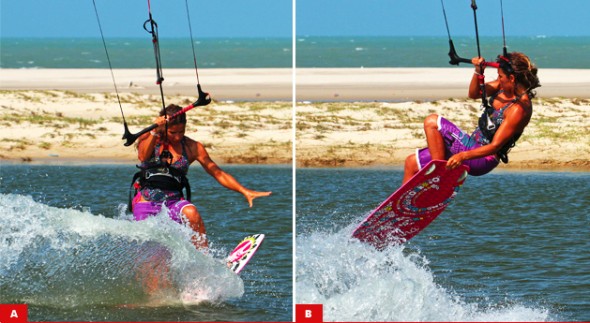
Pic B. and the front rotation have started from the impulse of her .p and her shoulders going forward and down. To make sure she gets enough rotation the rider has added in the”Timotei Flick), throwing her head around, looking over her back shoulder. She’s grabbed the nose of the board and pulled it right up to her derriere, bending her front knee. This will help with her rotation as well as adding some style. Also note the position of the kite – because the rider popped early (before the kite got to 12 o’clock) the kite is now above her. She has also pulled the bar in with her much centered hand. Not only does this give her the Float and time to complete the move, but if the kite stalls/flares a little bit it will pull downwind, giving momentum for the landing and keeping it away from the powerless edge of the window.
Pic C. The rider stayed in the position of the previous picture until she rotated around enough to spot her landing.  During that time she will have swung out under the kite a little bit, but with the bar pulled in and tension on the lines she has now started to swing back in. As she do. The rider focuses on her landing spot, releases her grab so that she can get her board down ready for landing, and pulls hard on the bar to dive the kite down for some extra power to pull her out of the move, complete the rotation, and forward onto the new tack.
During that time she will have swung out under the kite a little bit, but with the bar pulled in and tension on the lines she has now started to swing back in. As she do. The rider focuses on her landing spot, releases her grab so that she can get her board down ready for landing, and pulls hard on the bar to dive the kite down for some extra power to pull her out of the move, complete the rotation, and forward onto the new tack.
Pic D. A blink of an eye before landing and you can see that the rider has extended her legs to get the under carriage down, she’s now got both hands on the bar and is diving the kite hard. Most importantly though she’s looking towards the kite and where the pull is coming from. Ono of the many great things about this move is that  because of the pendulum effect you’ll be able to come out with speed and land on o carving edge, so following the kite and it’s pull is vital – don’t try and set up for your usual downwind landing.
because of the pendulum effect you’ll be able to come out with speed and land on o carving edge, so following the kite and it’s pull is vital – don’t try and set up for your usual downwind landing.
Top Tips
We will keep it simple and just recap two points. Drift the kite up, keeping the bar on the sweet spot AND go early, as soon as you feel the kite pull on your harness.
Your aim is to land this moving the other way without having to loop the kite for power, so finding a balance between speed, drift and timing is the key.
Other than that we would recommend learning this on bigger slower kites, with the sweet spot trimmed further away from you.
This combo will be more forgiving than a rapid 7m trimmed for unhooking. For the sequences we won’t take you through each individual picture but rather focus on what’s important for take-off, in flight entertainment and landing!
Sequence 1
This group of picture demonstrates the drift, timing, pop, grab and front loop. Although the pictures are spread out you will actually keep moving forward as you swing out. This is not on up and down elevator transition. The rider drifts the kite from 11 o’clock and as soon as she feels the pressure in her harness pops up hard into her rotation and grab. From that moment onwards she holds her position and keeps the bar pulled in, watching over her shoulder -looking for where she’ll land once she’s facing the other way.
Sequence 2
Here is all about balance. To finish her rotation and land smoothly the rider needs to get the power on by pulling hard on her front hand. She needs to do this as soon as she can see bock the other way, otherwise she could over rotate and land facing upwind. This will feel strange at first, as you’ll be pulled back towards the kite whilst your body is still twisted away from it. However patience as the pull has will straighten you up and almost magically set you up for the landing.
Common Problems
- Dropping from your rotation into the water whilst you kite flutters down like a leaf to the side.
- Assuming You’re rotating but very low. Two key fadors her, one 2. pop ear, that you did edge and pop the two most likely being the pop
- Come in too slowly and even if you kick off hard, you’ll just slow down too flying back once you pop, and it will fly to the edge of much and get no reward, read as pop, for your efforts.
Keystones
- Drift kite
- Pop early
- Keep bar in
- Watch for landing
- Dive hard
NIS
It’s a game of grip, harder you grip smarter you perform. We really appreciate your love and affection for this sport, which indeed is a plus point for health and working environment. Benefits are many and space is short to write, just wanted to summarize all the thoughts in one line “keep yourself moving until and unless something strange won’t pack you in a BOX.
Let’s talk about today’s trick from very beginning. Even if you already have an inverted Slim Chance in the bag, adding the non-inverted variant to your repertoire will be both satisfying and worthwhile. It’s likely that many of you and in particular some of the “old timers”, went on to master the Slim as the next step after the long forgotten dangle pass. With the result you may have a habit of sending the kite a bit and having a somewhat dangly finish to what started as a powered pass.
Getting your teeth into the NIS is a great cure for this. If you don’t suffer this problem, well it’s still another trick to claim and if you’ve never tried any sort of Slim Chance, now is the time. What should you already be confident with to try this? The base for this is a powered unhooked popped front roll, preferably to toe side, as that’s the way you’ll be passing. If you can already Shifty to wrapped, or even better Shifty 3 then you’re almost there, and if you can Front to wrapped then you’re knocking on the door That said your front rotation may not need to be inverted, but you do need to get the knees and board high, so the more aggressively you can pop, the easier this will be.
The Important Bits
- Approach and Edge
Pic A
Your first pass would be easier if you get good pop on your take off, it will be more to do with timing than brute force. And to get good pop your approach and subsequent carve onto your edge needs to be dialed in. It’s really important to get speed in starting, if you’ve got enough power great, if not work that kite to get some pull and speed. Secondly park the kite where you want it to be, let’s take it around 11 or 1 o’clock, so that you know it won’t drive you down and therefore give you the confidence to pop hard and not lift the kite as you edge. Finally get your body back over the tail of the board as you bear away, so that once you unhook not only will the kite be in the correct place, but also you can turn back onto a solid edge with your weight low very quickly, which is the crux of good pop. You can see in the Pic A that as the rider carves onto his edge and away from the kite his front leg is extended, his back leg bent but locked and his bum is low – a result of the correct entry position. From this point he is ready to pop hard.
- The Take Off
Pic B
If you’ve got the approach right you’ll have so much edge and bite as you turn the board upwind, that as long as you commit you’ll get plenty enough pop to complete the move without lifting the kite. Your board, knees and hips will be thrown up high enough to make the pass. Even though you’re throwing a front roll, you need to be as low as for as for a raley, uber edge your aim is to get yourself as much height as you can, which will give you time, so as you stamp hard against the back of the board, explosively extending your back leg, concentrate on extending from your back leg all the way up into your back shoulder. This way even as your head goes down and around and your front knee lifts to initiate the rotation, you’re still on the way up. In Pic B you can see the spray that the rider has following him, a definite rooster tail. As he goes down into the front roll he’s still rising. Just as importantly by popping hard Christian is able to bend his arms and pull his hands towards him, keeping the bar in close. If you don’t get the bar in now, you’ll have an almighty task ahead of you. Finally with the bar in close it is more achievable to keep the kite parked with the bar angled forward – if the arms extend you’re likely to pull on the back hand.
Pic C
It should be looking like at the 180° mark if all is going well this is what. Please watch carefully, the board and knees high, swinging around with your shoulders, not dropping and pulling you down. You need to be leading with your head, even though you’ll be throwing the pass against the rotation, as you need to see where you’re going so that you can time the movement. The rider is coming around and he still has his hands in close, if he were to rotate another 90° he would find his front hip nearing the bar. You don’t want this, so once you can spot your landing you have two jobs. Pull the bar in towards your hips, and pull your old back knee, in this case the rider’s right, towards the bar. They don’t actually have to get very close but this will slow your rotation and lift that end of the board, giving you more chance to make the pass.
- Do It
Pic D
This is the make or break moment requiring full commitment and energy. Timing wise you should be just about to drop, that lovely floaty nanosecond before free fall. Most likely it will feel too late, and if it does that’s perfect! In short you pass as you drop out of your rotation. Whilst your knee and bar move towards each other you have to turn your back on proceedings. Give one last tug on the bar with both hands, a bit front hand heavy to stop the kite flying up when you release it and then throw you head and shoulders back around, down and away from where you’ve been looking. Assuming you’ve already been wrapped or passing the drill is the same, fast and deliberate, twisting the bar as you release your front hand to allow your shoulders to turn further. In the picture the tail of the rider board is high, his knee and hip are close to the bar and he’s leading his pass with his head. He also has his complete kite face on, as this is 100%. With the board high and his knees bent the board won’t drop and pull his away from the bar as he turns.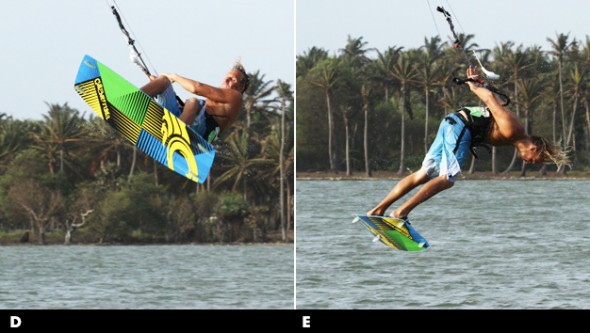
- The Pass [Pic E]
Now it’s hand to hand, which sounds obvious, however if you twist the bar fully and hold on tight your body will wrap around your arm, follow your head and the bar will present itself to your waiting hand. As long as it’s looking for the other hand and not scratching around in the small of your back. Here in this image the rider free hand finds the other one and grabs the bar. Now it’s just a matter of landing it, claiming it and riding away without looking too surprised.
- The Landing [Pic F]
This is a normal tendency that we don’t always think about the landings too much, but this one does require some anticipation, or else you’ll be passing, getting excited and then diving in. You need to be ready to ride as you land, hopefully downwind and maybe even further around. There are two things that really help. Firstly keep your head turning. It’s common to freeze the head whilst changing hands, and this often leads to a fall, so as you change hands keep turning the head to look towards where you’re going. Secondly untwist the hand, that is to say allow your wrist to turn palm down so that the bar is once again as it should be and the status quo is restored. By doing this your shoulder can turn up and forward and you’ll be better balanced to follow the kite. In the picture the rider’s hand is the right way up and his head is trying to look around, following his eyes.
Top Tips
- Your first key of success is “Preparation”, hence make sure you’re in a dynamic stood, as you’ll need to rotate quickly for the pass, and bang out a few popped front rolls
- Be focused on bringing the knees and hands closer as you’re coming around. Beware though, as this will kill your front roll rotation so be ready to land toe side and off balance
- At time you have done enough fronts that time is slowing down, you’ll get an idea of when you can pass. If you are able to bang out a few Shifty to Wrapped,or Shifty 3s, even better. It’ll get your pass rotation well and truly warmed up.
Common Problems
- Pop issues are common with front rolls as by the very nature of the rotation it’s very tempting to throw yourself down before you’ve gone up.
- Also there is a tendency to stand more upright whilst edging to pre-empt the take off, but you must edge low and hard, then stretch up to get the necessary height
- The problem with all passes this way is that the kite loves to rise, either as you pull or once you release. The beauty in the NIS is that as you’re waiting for the moment to pass, you have time to sneakily steer the kite down before or whilst pulling. Do this and the pass will be noticeably easier as you’ll practically manufacture slack
- Getting the knees and board up can be a problem. For the inverted Slim you can throw your shoulder down and head back to get the legs up. Whereas here it’s all about pop. However keeping your hands in close with bent arms will mean that your balance point will be more around your waist and therefore you’re more likely to rotate around this axis
- If your arms are stretched out it’ll be much harder. Finally the landing. Passing like this does encourage you to look down at the water as you throw your head, which works wonders for the pass but doesn’t do jack for the landing. So make sure you try and move your head after passing and untwist your hand.
Keystones
- Good approach and solid pop
- Hands in close
- Bring hands and knees together
- Pass late, as you drop
- Keep looking
Nose Grab Front
In today’s world we have made it very easy for everyone to be more skilled in kitesuring. Now information is easily accessible on internet and people paste their experiences in the form of blogs, articles and share the best way to enjoy this sport.
So in continue to that here is our guide to a popped front roll with a Crail or Nose grab thrown into the mix for extra spice. The grab itself is done with the back hand reaching forward and touching, stroking or preferably holding either the nose of the board or as near as possible on the toe side way up near the fin. It goes without saying that you’ll already need a competent popped front to nail this beauty, as the more powered it is performed with, the better the axis of rotation will be and thus all the sweeter the grab will look. Let us remind you of a few vital key moments for a decent popped front whilst also sneaking in the grab.
Coming In
You need to approach in the right way if you want pop, as it will not only help in getting up and off the water, but also the rotation and the landing.
Image A. the rider is perfectly set up for some hefty pop. With her kite parked just below 11 o’clock she pushes the nose of the board off the wind and flexes her back leg to flatten the board, increase speed and move towards the kite, allowing it to drop back a bit in the window. At the sometime she has all her weight, hips, head and shoulders dropped back over and behind the back foot. Her hands are centered and she has her bar trimmed in enough that she can get into this position without pulling too much tension onto the back lines. We always recommend moving your front hand over the middle of the bar, centre line between your first two fingers if you can. This will allow you to keep the power on throughout the move without the kite diving down.
Take Off
Going into a popped front rotation it is all too tempting to drift the kite up and wait for something to happen, which will inevitably lead to a dangly and uncontrolled spin under a very high kite. It’s a mast to keep the kite flying forward and get your height from a very aggressive pop. Breaking the pop and rotation apart, even just by a millisecond will make all the difference. If you concentrate on going up before throwing your head around and shoulders down you will get enough height. If you dive straight into the rotation you’ll not extend up and rather fire yourself down towards the water.
Image B. is showing the rider popping up hard. Having carved rapidly back up onto her edge with her weight still back, she has now stamped down hard, pushing her back leg down against the edge of her board and extending her body upwards for maximum pop. She keeps her front elbow tucked in and bent to prevent the kite from drifting up and the bar is still angled towards the kite as if she were riding. The only give away showing a prospective front rotation is the bending and lifting of the front knee.
When you relies that that you’re on the way up you need to get spinning and think about the grab. You won’t have long in the air so its chop chop. To start the rotation lean the head and shoulders forward, so that you are going with the pop. By lifting the front leg and allowing your body to be kicked up you will start to rotate from the back legs impetus. Turning your head to guarantee spin will help, but if you whip around too quickly it’ll be tricky to get the grab in early enough. As for the grab you need two actions, release the front hand and start to reach forwards, and you must bring the front knee up and across your body to bring the nose of the board within reach.
Image C. the rider is just off the water and she already has her front knee up and across in front of her. She resists the temptation to pull her back leg up and keeps it straight – with it extended the nose of the board will tip even closer to her. She allows her head and shoulders to tip down and forward into the rotation as she fully extends up and keeps the bar pulled in. Her back hand is reaching down towards the already well-positioned board.
The Grab
Early grab will give you two advantages.
- The first is purely aesthetic, you’ll be able to hold it for longer and thus it’ll be more noticeable.
- The second however is more functional – once you have the grab you can pull the board in, making you small and then concentrate on getting around the rest of your front roll.
Theoretically at least, if you get the take off right the grab should fall into place.
Image D. As a result of all the hard work the rider has got a pleasantly satisfying pop, good height and controllable slow rotation. This allows her to get her hand onto the nose area before she has rotated 90°. Keeping the front knee up and releasing the back hand early were key. Keeping the bar in and power on guarantee that she won’t just drop out of her rotation, but will continue to be pulled forward.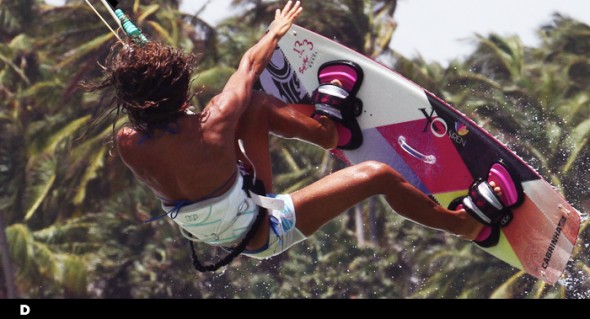
The Money Shot
Once you’ve got the grab, hold it. As stated before, this isn’t just for poseur status, massaging your ego or blatant show boating, but with a solid hold of your board you can pull it in and turn your head and therefore finish your rotation.
Image E. With her grab held the rider turns her head to spot the landing. To speed up her rotation she has pulled both knees up whilst still holding the bar in, keeping the kite moving forward and pulling.
Touch Down
Aim to hold your grab for as long as possible, until you complete the rotation. You’ll find the timing quite natural, as you’ll need to let go to allow your board to drop under you as you start to drop. Assuming you went off the wind in your approach you should come around to a comfortable downwind landing towards the kite, which will kill the power in the kite and make tutu comfortable stomped landing.
Image F. You can see that the rider has released the grab and lets her legs and the board drop down beneath her for a solid reception. She still has pulled in so will land following the kite with her weight squarely over the board.
Top Tips
- A good pop and confident front roll are key, so before throwing yourself up into one of these get warmed and ready with a few two handed front rolls. When you’ve knocked out a few high and controlled ones you’ll be more confident to go for the grab.
Common Problems
- If you’re struggling to reach the grab there are two solutions. Firstly if you can already nose or nearly nose (troll) grab the board in sent jumps or front rolls try popping with the kite higher, or even drift it up a tad
- With a higher kite and a more vertical rotation it will be easier to reach the board. Secondly if you’ve never tried a two grab before and you’re finding it tricky here, revert to getting the body movement right in a sent jump and then a sent front roll. Videos and Sequence for the entire visual path….
Keystones
- Bear away with weight back for god pop
- Extend up fully
- THEN release back hand and start rotation
- Bring front knee up and across
- Hold grab and turn head
Double Back Rool Transition
Adding together some extra rotation is a sure shot fire way of stepping up a move that you already have mastered, and the double back roll transition is definitely up there as one to learn, so here it is. Although some warning words are here, if you’ve been practicing the double back roll kite loop from last issue, you may require to rewire your brain and press default as these are two clearly different moves wherein you definitely don’t wish to be confusing. A very good base before starting this is a solid and controlled, BLT, or back roll transition if you’re from across the pond. From this point below is what you will be doing.
The Approach Pic A.
Vital 2 things to remember for any transition are; you have to kill some forward momentum and then you still need to send the kite for lift. You certainly require a good edge for both of these elements. From a good edge you can edge harder upwind to slow down, and with a good edge you can send the kite rapidly and sharply from either 11 or 1 to 12 o’clock because you maintain tension in the lines. If you think about this you won’t drift the kite up slowly whilst standing up on the board and your chances of success will be greatly increased. Please note and also see in Pic A that the rider has come in with good speed on a decent edge, kite at 11 o’clock, weight back and tension in his lines.
From this point the rider has sent the kite up whilst edging harder to both resist the pull, and also to slow down. Even though his back leg is bent it is not soft – it is pushing and therefore resisting.
The Rotation Pic B.
A certain element of trial and error with good amount of practice is what required for this part, depending on your standard BLT. In case if you are a recognized exponent of slow, casual-looking back roll transitions then speeding up the rotation to accommodate an extra 360° shouldn’t hold much of a problem. If however you’re guilty of the occasional foray into spinney quick low BLTs, then you’ll need to focus more on your approach and the take-off, in search of more height and float, which added to your spin speed should see you nicely round the full double.
We feel it extremely important to mention here that that you do want to help yourself into the second rotation, but you don’t want to force it as later in the move you can use your head, body and kite to help you finish. The rider I Pic B. has dropped his weight way back over the tail of the board. With his weight so far back the board will turn/carve much further into the wind as it is almost pivoting on its tail. This will efficiently speed up the rider’s rotation as he will carve further into wind before take-off than for his standard BLT.
The important tool here is timing, you must drop back as the kite starts to lift, a fraction before you take off. This way you’ll still edge and therefore be rewarded with some air and float. If you drop back too early you’ll be pulled back and the kite will fly further back in the window, offering you less time in the air to make it round the two times.
Take Off Pic C.
Here comes the key moment, though your approach will dictate how this goes. If you have edged and resisted and literally stabbed the kite back hard but face short time you will be able to pop up off your back leg as you pull the bar in whilst the kite is somewhere close to 12 o’clock.
The rider has pulled the bar right in after popping. The reasons for this are twofold. Firstly by pulling in hard with 2 hands the rider successfully stops the kite moving and keeps it centered above bias around 12 o’clock. Secondly he gets a cheeky bit of extra lift from the kite. However be cautioned if your sweet spot is trimmed miles away from you, your kite will flare/stall and you will not get the float or control that you’re expecting. As he takes off he keeps his head looking forward between his arms, which will stop him over cooking the rotation. Finally the rider in this image lifts his knees, making himself small, balanced and easier to rotate.
By the time you reach to the peak of your transition, your aim is to complete your first rotation, so one on the way up and then one on the way down. That means unless you’re getting great height there won’t be much time to separate the move into two halves.
You are ready and primed to go into number two as you complete the first 360°, it’s the most important thing here. Check images number D. that the rider has lifted his feet above him and has his knees pulled in close. This a little inverted position will make it much simpler to finish the move, as with your feet high and knees in, your whole body, legs and board will follow your head and shoulders as you turn into the second rotation. It is absolutely possible to finish the move with the board down low, however you are far more likely to finish with your head and shoulders, but find that the board has been left somewhat behind – which will hinder your smooth landing. In picture you can see that the rider has started to pull, gently at first, on his left hand (old back hand, new front hand – whichever way you prefer to think). This gentle movement of bar and kite will encourage you to lean back into the second rotation
Turn and land pic- E
Your second rotation will come from a combination of your head and the kite. With your feet up look around and you’ll continue to turn and the rest will follow. You can see that the rider is attentive on where he will land, and as soon as he feels that he is rotating, he dives the kite down hard. The pull from the kite twists him around and powers him up for a down wind landing.
One thing which really important is Timing here in this trick , but if you pull too early the kite will end up low with little power and as such you’ll be forced into a late kite loop once you have landed to keep you dry. If you time the dive well, you’ll get the perfect dry landing without needing to loop the kite.
Top Tips
- Start with some single BLTs, focused on the edge, send, upward take off and keeping the kite above you at 12 o’clock throughout the move.
- Once you’re comfortable, confident and consistent bring your feet up and go for the second rotation whilst keeping the kite at 12.
- Once this is in the bag you can dive hard to add the perfect 10 landing! If you’re struggling with the slow rotation, concentrate on the up rather than the spin and approach with less speed and more edge, whilst sending more aggressively – but just for a short moment.
Common Problems
- The most common problem here is implementation the move but landing with the kite so for at the edge of the window that there is no way to get any power to get moving.
- There are two probable reasons for this. Firstly you’re drifting the kite up rather than sending, so you feel the lift late and the kite has already travelled too far behind you.
- Secondly as you take off your leaning back onto your back hand, so you don’t stop or even redirect the kite to 12. Concentrate on performing the move with the kite at 12 o’clock and then add the kite dive on at the end.
- The other famous problem is not having enough height to land cleanly, so you are completing the double but always landing on an edge across the wind with your burn in the water.
- This can generally be linked with concentrating too much on the rotation and not launching yourself up into the move. Make an effort to pop up into the rotation, and not just carve around into the wind.
Some Keystones
- Good solid edge with legs resisting
- Send kite positively with confidence
- Pop up into the back roll and center bar
- Keep Kite at 12 o’clock and lift legs
- Turn head at apex and dive kite to complete number two
Back Loop One Foot
Kite surfing is an grand sport and also proven one of the best exercises for your body & your mind. Being a pleasurable, social sport, kitesurfing can increase your levels of health and fitness with no doubts.
Hopefully you did your boned back loop grab homework! Here is the natural progression, once again based on the humble sent back loop, grabbing the tail but adding a stylish one foot into the equation!
The Approach Pic A.
To have the time in the air to get a foot out and still land you’ll need to perform a dos, and floaty back rotation. Approach wise you need to be coming in on a good edge with the kite parked at either 11 or 1 o’clock. Get your weight back by extending your front leg and dropping your bum over the back foot, whilst still resisting. You can see that the rider is low to the water and edging hard upwind. From here she can send the kite aggressively with both hands for a decent floaty jump.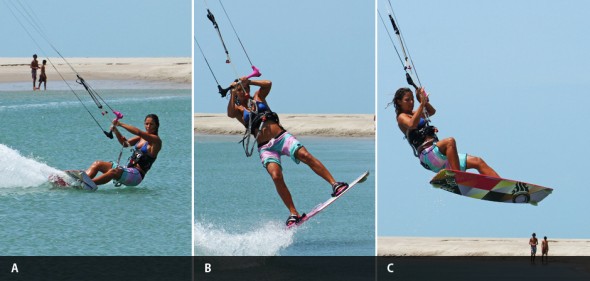
The take off Pic B
This part will really decide how much time you’ll have and how slowly you’ll rotate. Having sent the kite hard against a good edge the lift from the kite should come early, once the kite is around 12 o’clock. As soon as the rider feels the pull she stamps up off her back leg, extending her entire body up in a popping motion and simultaneously pulls the bar in, both for extra lift and to stop the kite moving any further back in the window. By popping up the rider is carving up into her rotation but she isn’t turning further into wind and therefore she won’t spin uncontrollably. All the while the rider keeps her head looking forward through the bar, again making sure that she doesn’t rotate quickly so that the grab and one foot will be simpler.
Go Early Pic C.
Just the same as the grab, you must go early, but only after you have extended up into the rotation.
As soon as she has left the water she is looking for the grab and already bringing her back foot up towards her extended back arm. The earlier she gets hold of the board, the more time she’ll have to grab and concentrate on getting around smoothly and landing softly! Go for the grab just as you have practiced so whether you grab the heel side edge of the board or the actual tail doesn’t matter, whatever feels comfy and natural.
Slip It Out Pic D.
It will be easier to get your foot out if you have the board edge up, as opposed to flat. 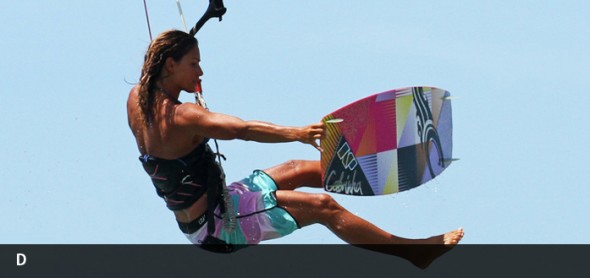 This way gravity will help and with the smallest of encouragement you should be able to get your pinkies free. You can see that the rider is still looking at the board, she looked for the grab and then focused on the foot strap so that she can see what she is doing and this also has the added benefit of keeping her head from looking over her shoulder, and thus keeps her rotation slow, giving her plenty of time for the one foot. The rider can now hold the board up whilst she pulls her foot out and down, easily releasing it from the strap. If the board is held flat it will be harder as you will have to pull your foot out towards you, which requires more flexibility or longer arms. On your first attempts aim just to get your foot out onto the pad. Once you’re confident you can extend your leg, pushing your foot down towards the water for extra style and look at me points. Final point to ponder here is that even though the rider is flying the kite with one hand, she still has the bar pulled in. This gives her support and float, whilst keeping tension on the lines, meaning that the kite is ready for the eventual landing.
This way gravity will help and with the smallest of encouragement you should be able to get your pinkies free. You can see that the rider is still looking at the board, she looked for the grab and then focused on the foot strap so that she can see what she is doing and this also has the added benefit of keeping her head from looking over her shoulder, and thus keeps her rotation slow, giving her plenty of time for the one foot. The rider can now hold the board up whilst she pulls her foot out and down, easily releasing it from the strap. If the board is held flat it will be harder as you will have to pull your foot out towards you, which requires more flexibility or longer arms. On your first attempts aim just to get your foot out onto the pad. Once you’re confident you can extend your leg, pushing your foot down towards the water for extra style and look at me points. Final point to ponder here is that even though the rider is flying the kite with one hand, she still has the bar pulled in. This gives her support and float, whilst keeping tension on the lines, meaning that the kite is ready for the eventual landing.
Back In Pic E.
At first keep your back foot close to the strap when you take it out. This way you can literally pull your foot out and leave it resting on the pad, so to get it back in you just need to push it. As you gain confidence start to extend your back leg once you have taken the foot out take the foot so that it is more obvious. You’ll need to keep your eyes on the prize, 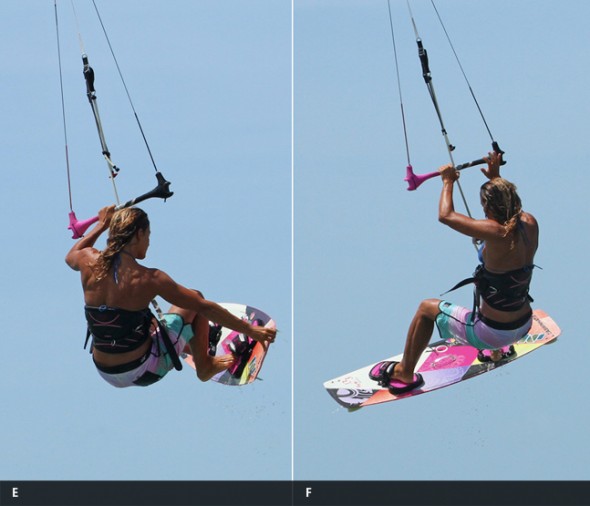 so watch the strap and aim your foot back in. Once your toes are in, use your grab and push your foot and/or pull the board to make sure that your foot is properly in.
so watch the strap and aim your foot back in. Once your toes are in, use your grab and push your foot and/or pull the board to make sure that your foot is properly in.
This is not essential but it will make the landing considerably easier. If only your toes are in you’re more likely to trip over your toe side edge when you land.
The Grand Finale Pic F.
Once you have your foot safely back in the strap it’s all about preparing and conquering the landing. Your first job is to make sure that you finish the rotation, so turn your head and look towards your potential landing zone, which should be in front and downwind of you. Don’t be tempted to look too far around as this will encourage you to over mists. Job number two is to get two hands on the bar so that you can comfortably pull the bar in and dive the kite, which will both pull you out of the rotation and pull you downwind for your landing. You can see that the rider is looking downwind whilst reaching up for the bar. From here on in she’ll dive the kite and land with the board facing down wind, claiming the one foot.
Top Tips
- Assuming that you’re happy with your slow rotation the most important part to concentrate on is getting the grab early.
- If you do, then you will have more time to get the foot out and then back in.
- Do concentrate on looking at the foot strap to get your foot out; making sure the board is edge up.
- Finally do wiggle your back foot out of the strap a little before you take off, or even loosen the strap so that it is easy to slip in and out.
- Now have a good look at the Sequence and the get the grab early and don’t use your head. Videos for a full step by step guided tour.
Common Problems
- Most of the potential problems will be the same as for the grab, so over rotating or flying the kite forward too much when you grab.
- If it’s not working make sure that you take off up into your back rotation, If the kite pulls you forward in the air, causing you to lose balance, land nose heavy or crash, send it a bit more for the jump so that you’re flying with the kite just behind 12 o’clock.
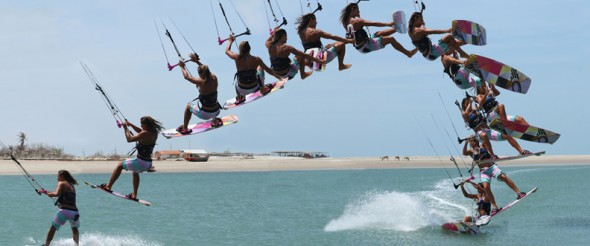
Keystones
- Good solid edge with back leg resisting
- Send kite positively
- Pop up into the back roll
- Grab early and tilt the board edge up
- Look at strap to get foot out and in
Indy Pop to Blind
Before trying Indy pop to blind trick you must be reading well below instructions and practice it with right way. You can have every possible trill which is there in kite surfing. By understanding what to do and how to do can make all the difference.
And as we have often said it’s a great way to freshen up and reignite your passion fats move that you already have in the bag – so it’ll not only look the puppy’s but also feel do booth! Here we have a hooked in pop to blind with a back hand grab on the toe side rail in between your feet. You should already have the ability to pop around to blind and ride and if you don’t then hopefully this will be the incentive you need to learn.
The Set Up- Pic A
When you search for your pop you will require two things, the obvious one being speed with a dose of power and the less obvious one is a good body position, which is always much required. Whilst learning you can afford yourself the luxury of a third one, which is lift from the kite. No need to have it down at 45° when a forgiving 1 or 11 o’clock will help you on your way. Here we can see in the image that the body position as the rider carves back up into her pop. Her front leg is extended, meaning that her hips, and weight are pushed back towards the tail of the board and her shoulders are also leaning back. Surfer adopted this position before she turned off the wind and has held it throughout her carves. This very sturdy position enables her to pop explosively off her back leg. Before we continue take note that your hands should be centered on the bar and your kite parked still.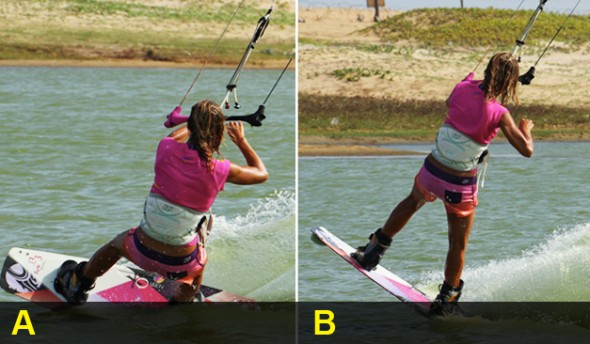
The Explosion Pic B
From such a solid set up the pop should be easy and simple. As long as you turned off the wind before carving up both the kite and the board will behave, that is to say the kite will give you something to pop against and your board won’t slow down too much as you carve. To get maximum pop you must keep your shoulders back and upwind of the board, your bum low and close to the water and you must not soften your back knee as you carve up. The rider has stamped down hard against the board with her back foot, explosively kicking herself away from her edge, and with her weight back and she takes off nose first. In anticipation of not having much time to grab she is already releasing her back hand from the bar as she stamps.
Board Up Pic C
As with any pop you need to wait until you’ve extended your body to get full elevation up, but as soon as you have it’s chop-chop to get the grab in. In picture, having already released hand, her next job is to bring her knees up towards her so that the board is within grabbing distance. The rider looks down towards where she’ll grab as she lifts the board and keeps her knees apart so that there is room for her arm to reach down towards the edge of the board. Also as a result of popping hard the back of her board kicks around and out slightly which has the effect of turning the rider back and away from the kite. This is good as it pushes which in turn gives her more room to reach down with her back hand.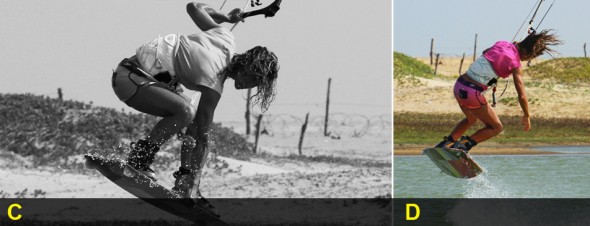
The Grab Pic D
With the board flicking around, roots for the back hand to reach down and the knees pulling everything up she can happily grab the board for a solid Indy. In this picture you can see the result of all that has gone before – the bar is in front of her and she has plenty of roots to reach and hold the grab without the need to be a contortionist. Whilst you have the grab sirs to keep the bar in on the sweet spot so that you’ll have a modicum of support from the kite, you’ll keep your forward momentum for the landing, and you’ll be able to dump the pull when you need to turn to blind.
Throw the Blind Pic E
A very good thing about the grab is that it naturally makes you stall your turn or throw to blind. Blind is always a last second movement, hence why we can do a by pop to blind. The higher you go, the longer you have to wait in order to keep your balance and control the landing. Once you feel that you’ve got the grab and you know that you’re coming data it’s time to turn. The action will come from your hips and your back leg whilst your free arm will balance you. The rider has released her grab and now commits to blind. To turn the board she twists her hips and pulls her back leg up towards her bottom and around towards the water. The board will naturally want to fall tail first so she focuses on pulling her back leg up. By doing this she will rotate around her harness hook and should make it all the way.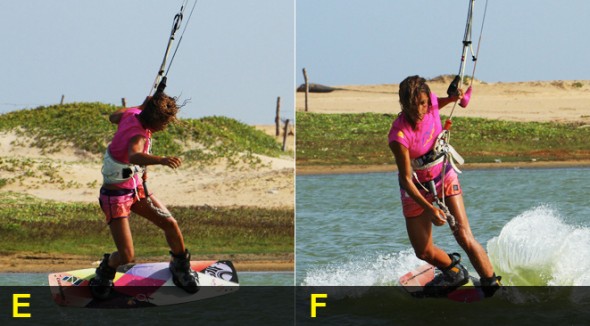
Landing Pic F
Landing this should be as per your pop to blind, though chances are as you’ve had more height you will have less momentum to keep you going once you plant the board. Make an effort to keep your back foot up so that you can plant the front of the board into the water for landing. This way as the nose catches the board will pivot off the wind more and you’re more likely to keep moving. If you land flat on your edge you’ll just stop. You can see that the rider has landed nose first with her front leg fairly straight, whilst her back leg is bent so that the board will turn further away from the wind on landing
She is already in her default blind position so that she will keep moving. If you have slowed too much pull the bar in to get some oomph from your kite.
Top Tips
- First of all you should practice the Indy if you never tried it before.
- Getting the board flicking you slightly around on take-off does make the movement of turning to blind in the air much easier as you have less far to turn and thus your body is in a better position.
- Try looking back at where you came from as you grab, this will help you turn during your Indy.
- Although we’ve said you don’t want your kite too low, don’t have it any higher than 11 or 1 o’clock. It still needs to be pulling forward to allow for some flick, an easy grab, and momentum on landing.
Common Problems
- If you can’t reach to the grab then ensure you’re popping hard enough. The pop will help you lift the board as the water will cork the board back up at you.
- Also make sure you turn to face slightly back to get the bar and your harness out of the way.
- If you’re falling backwards as you land. If your body is further downwind than the board when you land you need to sheet the bar out as you throw the blind.
- If you’re landing and then falling chances are that you’re landing flat or tail first, so concentrate on keeping that back foot up and close to your bottom so that the board can pivot.
Keystones
- Turn up and pop hard
- Release back hand and look for grab
- Lift board and look back
- Throw to blind using hips and back leg
- Keep back leg up to land nose first
One Handed Tabletop
It’s a classic one and it will never going to get out of style. Now you can learn this from TOP to bottom with the aid of below instructions. And to do this trick you need to understand that it’s a wind game and there is no surprise knowing that when the wind is high, you have to walk with it and literally kiter’s bag of tricks can be weaken. Bye this reason expanding your air game is a very mandate, hence when the wind calls, as it so often does when you’ve set your heart on unhooking or that cheeky dark slide, you can still have an array of moves to amaze your peers and more significantly keep yourself well entertained. Today’s trick “The table top” comes very much from windsurfing and was championed in kiting by many of the early adopters. All you really require is to be happy with a grabbed jump; if you can ride blind you’ll have the movement already!
If you’re not certain what a “Table top” should look like, just go through with the sequence images and get the right idea. This move requires you to take your back hand off the bar and throw it behind you whilst twisting your body and scissoring your legs. The more you invert the more likely that your board will be upside down and that is when you have a purist’s table top. However on a twin tip we reckon not inverting too much looks better, but whatever rocks your boat. So here we proceed to it.
The Foundation Pic 1
Your prospective table top won’t be much if you don’t provide it the legs on take-off. You will be hanging slightly off your front hand as  you swing yourself into this and therefore your jump needs to be more send than bow. You can see in images that rider has given the kite a good send by the angle of his bar. Over here the push and pull action is very important as you’ll have your hands very centered so that you don’t make any rash moves once you’re up, but this does mean that your hands have less impact when you send the kite back. You need a decent send to give you the height and get you flying with the kite behind 12. If you don’t send it past 12 and just pull in for lift you will redirect the kite too much once you go for the table top. How far back you go will depend on kite size and wind strength, nothing too extreme as you still want float. Needless to say Christian has a good edge coming into this and he is looking upwind not at the kite.
you swing yourself into this and therefore your jump needs to be more send than bow. You can see in images that rider has given the kite a good send by the angle of his bar. Over here the push and pull action is very important as you’ll have your hands very centered so that you don’t make any rash moves once you’re up, but this does mean that your hands have less impact when you send the kite back. You need a decent send to give you the height and get you flying with the kite behind 12. If you don’t send it past 12 and just pull in for lift you will redirect the kite too much once you go for the table top. How far back you go will depend on kite size and wind strength, nothing too extreme as you still want float. Needless to say Christian has a good edge coming into this and he is looking upwind not at the kite.
Get Settled Pic 2
Once you do take off make sure you’re balanced, settled and that the kite is where you want it, just behind 12 o’clock. There is no great rush as you won’t be able to hold the one handed position indefinitely. As the rider launches himself skywards he brings the bar in to make sure that he’s got tension on the lines for float, and this also lets him feel if the kite is supporting him and from where – you’ll feel the kite pulling from anywhere but up if it’s in the wrong place!
that the kite is where you want it, just behind 12 o’clock. There is no great rush as you won’t be able to hold the one handed position indefinitely. As the rider launches himself skywards he brings the bar in to make sure that he’s got tension on the lines for float, and this also lets him feel if the kite is supporting him and from where – you’ll feel the kite pulling from anywhere but up if it’s in the wrong place!
By pulling the bar in with two hands it guarantees that the kite won’t move much as you release and swing into the move.
The Moment of Truth Pic 3
Now that you’re comfy it’s time to go. The rider has released his back hand, swung his arm back and turned his head to look down at the water behind him. This action will swing you around so that along with your hea d, your body and legs will turn too. Looking down allows your shoulders to drop, which will lift the board a little. The movement itself is fairly simple, almost like throwing a blind in the air.
d, your body and legs will turn too. Looking down allows your shoulders to drop, which will lift the board a little. The movement itself is fairly simple, almost like throwing a blind in the air.
However do take note of the fact that he has kept the bar in close to his hip with his front hand. This keeps the kite sheeted in and more importantly keeps you in the air – don’t be tempted to extend your front arm as you extend and swing your back arm.
Tweak It Pic 4
Once you’re happy with the first swing and twist you can tweak yourself into a more extended position, the canvas is now yours. The rider has reached down with his free arm to lift the board further, and pushed the board up and away from his by extending his legs. The trick is now trying to hold it, fighting gravity whilst keeping the bar in. The two simplest variations of this are to invest more by throwing your head back as you turn and to pull your back leg into your bum, keeping the front boned for a more classic position.
The Return Pic 5
In this image, you will find that the weight of board will get the better of you and the board will start to swing back around. As soon as it does make an effort to get your back hand back on the bar as this will help you to control the rest of your flight, and as the rider is doing in the picture, try to lift your knees to cut the pendulum effect of your board.
Swinging Down Pic 6
 This is similar to happen if you do get a bit of tweak to your table top, so be ready. As rider’s legs and board have swung down they’ve created a fair bit of inertia, and so on they go, swinging his merrily so that his front foot turns upwind. If you’re happy to land toe side then there is no problem, but if you had good height and would prefer to dive the kite hard fete soft landing try to keep your head and shoulders facing forward, core tight and dive the kite hard as per usual. As the kite pulls it will help you turn the board back downwind and land as you normally would.
This is similar to happen if you do get a bit of tweak to your table top, so be ready. As rider’s legs and board have swung down they’ve created a fair bit of inertia, and so on they go, swinging his merrily so that his front foot turns upwind. If you’re happy to land toe side then there is no problem, but if you had good height and would prefer to dive the kite hard fete soft landing try to keep your head and shoulders facing forward, core tight and dive the kite hard as per usual. As the kite pulls it will help you turn the board back downwind and land as you normally would.
Top Tips
- As we often propose, a few incremental steps along the way to your goal will make it easier, so on your first few attempts just go for a little look back and down whilst keeping two hands on the bar, then move on and release your back hand, and finally when you’re feeling confident give it the swing and let your body and legs twist.
- Keeping your front hand held in tight against your hip is a must. This will enable you to twist back around at any time as you’re locked to the bar.
- Make sure that your front hand is butted up against the centre line in the middle of the bar.
Common Problems
- Your main obstacles will come from the kite and the swinging through on landing.
- As with all one handed moves you are at risk of moving the kite when you least want to, so if you do find that it’s flying forward and pulling you off balance into a front foot heavy landing or a splash, make sure that it is behind 12 o’clock before you take your back hand off.
- Also make sure that you are swinging yourself into the table top and not pulling yourself into it with the front hand.
- Having that hand locked in and stationary is very different from pulling against it to move your body weight.
- If you’re struggling with the landing as your legs swing through chances are you’re not diving the kite hard enough to help get you back to a downwind landing position.
- This is a leap of faith but just as when you learnt to jump, the pull from the kite for landing does and will help.
Keystones
- Send kite past 12 o’clock
- Balanced with bar in on way up
- Release back hand
- Swing arm and look down
- Keep front arm locked in
Front Foot One Foot
This is really a fun of highest order. You’ll confuse yourselves at first, however be rest assured that the Triple “F” is astonishingly easy and is guaranteed to put a smile on your face – it is a show boating with a sense of humor. Now on serious note what do you need to bash out one of these? Practically if you can jump with a tail grab and loosen your straps you are good to go and actually ready to rock and pose.
Preparation
Get yourself prepared before you hit the water. To free your foot temporarily from the confines of your front foot strap you may want to loosen the strap a tad so that your foot can slide out, and probably more significantly back in effortlessly without hindrance or interference. And if you’re going to loosen the front one you best loosen the back one a touch too. With this way if you don’t get the front foot back in it’ll be simple to ditch the board pre splash.
Image-1 (The Jump)
If you’re not as quick as Flash Gordon getting some height and float from your jump is paramount so that you have time to grab the board and set free your foot, get it back in without stubbing your toe and then land . Preferably you’ll wish some power in the kite, a jolly good edge and some space. Start with your kite no higher than 11 or 1 o’clock. Once you know it’s there,
. Preferably you’ll wish some power in the kite, a jolly good edge and some space. Start with your kite no higher than 11 or 1 o’clock. Once you know it’s there,
Look upwind and drive against your edge, pushing against your back heel ready to resist the extra power that you’re about to create. Now wiggle your front foot a little out of the strap so that it is not wedged in and send the kite hard with a decent pull push action, keeping the bar on the sweet spot. Keep edging, keep the bar in and wait for the kite to launch you. Only if you edge well and send kite hard you will get the up earlier and the kite won’t fly too far behind you, making it easier to focus on the task in hand. We’re looking for an elevator jump here, so more up and down, not flying at mach 10 downwind.
Image-2(Knees up)
 As with any foot out and board off you, need to get everything in position as soon as possible, so that you’ve got plenty of time. If you only manage to get the grab in on the way down your chances are getting slimmer. Here in this image you can see that straight away after take-off rider is getting his knees up towards him. This needs the most effort as the lift from the kite is straightening you out, so you’ll need to pull hard and its maybe why the rider in the picture doesn’t look too happy. Please have a look at his bar – he has pulled it in and also leveling it. This way he gets the kite settled just behind 12 o’clock with two hands before getting on with business.
As with any foot out and board off you, need to get everything in position as soon as possible, so that you’ve got plenty of time. If you only manage to get the grab in on the way down your chances are getting slimmer. Here in this image you can see that straight away after take-off rider is getting his knees up towards him. This needs the most effort as the lift from the kite is straightening you out, so you’ll need to pull hard and its maybe why the rider in the picture doesn’t look too happy. Please have a look at his bar – he has pulled it in and also leveling it. This way he gets the kite settled just behind 12 o’clock with two hands before getting on with business.
Image-3(Look for the Grab)
Pay your attention on where you wish to grab the board, as this way you’ll get there earlier. Turning your head to look at the tail will also turn your body and the board, which is a good thing. By turning the board back you have more space behind your harness to lift your back knee and get the board closer to you. Lifting the back knee and the back of the board towards you tilts the board which aids un-weight your front foot and makes it easier to slide out. You can see that everything is happening behind the guy in the picture, so he has plenty of room to do maneuver
Image-4(Make It Count)
Of course! This moment is full of glory, so stoke it count. Once you have the tail of the board pull it up and in towards your bottom,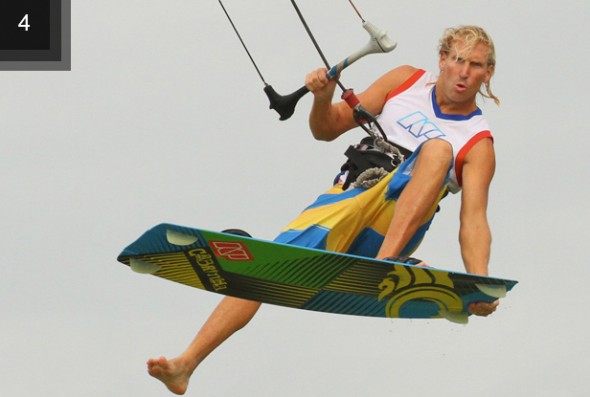 as this will aid twist the board off your foot. At the same time lift your front foot towards you, your foot will now be dangling in told air. Keep your hold tight on the board and keep your bar in for float. From this moment you have a plethora of alternatives to show-off, the most significant of which is to get your front leg extended as the guy has in the images. As you get confident you can play with board angles and leg positions. As per any reasonably high and float jump, aim to keep the kite just behind at the angle of 12 o’clock so that you don’t get pulled forwards and off balance whilst in flight.
as this will aid twist the board off your foot. At the same time lift your front foot towards you, your foot will now be dangling in told air. Keep your hold tight on the board and keep your bar in for float. From this moment you have a plethora of alternatives to show-off, the most significant of which is to get your front leg extended as the guy has in the images. As you get confident you can play with board angles and leg positions. As per any reasonably high and float jump, aim to keep the kite just behind at the angle of 12 o’clock so that you don’t get pulled forwards and off balance whilst in flight.
Image-5(Eyes and In)
 In the time when you are learning this, once you experience that you’re dropping it’s your signal for font foot in. This way you’ll have sufficient time. Once you get more proficient and confident you can wait until mill moments before landing. To make life easier and give you a bit longer you should start to pull gently on your front hand. This way the kite will fly at 12 o’clock and you’ll be satisfied with a little extra lift, and therefore time. If you don’t perform this, you’ll drop much quicker. Fix your gaze on the front strap and pull your back knee up, which will tilt the nose of the board down. Bend your front leg to bring your foot up and if your strap is loose it should be a fairly simple procedure. Once your foot is in give it a wiggle whilst you still have hold of the tail to make sure that it’s secure.
In the time when you are learning this, once you experience that you’re dropping it’s your signal for font foot in. This way you’ll have sufficient time. Once you get more proficient and confident you can wait until mill moments before landing. To make life easier and give you a bit longer you should start to pull gently on your front hand. This way the kite will fly at 12 o’clock and you’ll be satisfied with a little extra lift, and therefore time. If you don’t perform this, you’ll drop much quicker. Fix your gaze on the front strap and pull your back knee up, which will tilt the nose of the board down. Bend your front leg to bring your foot up and if your strap is loose it should be a fairly simple procedure. Once your foot is in give it a wiggle whilst you still have hold of the tail to make sure that it’s secure.
Image-6(Both Hands and Dive)
 Now all that’s left is to land this with panache and you’ll feel quite chuffed. Once your foot is in release the grab and get you back hand on the bar. You’ll need to dive the kite hard for landing because you gave it a little pull forward for support whilst replacing the front foot, so if you’re not aggressive now you’ll get pulled off balance as the kite flies around the edge of the window. You can see that rider is giving the bar a fair yank down to dive the kite and as it pulls he angles the board off the wind for a soft downwind landing.
Now all that’s left is to land this with panache and you’ll feel quite chuffed. Once your foot is in release the grab and get you back hand on the bar. You’ll need to dive the kite hard for landing because you gave it a little pull forward for support whilst replacing the front foot, so if you’re not aggressive now you’ll get pulled off balance as the kite flies around the edge of the window. You can see that rider is giving the bar a fair yank down to dive the kite and as it pulls he angles the board off the wind for a soft downwind landing.
Top Tips
1. Approach your first few attempts with an aggressive jump, a boned grab and a subtle look back to get your confidence up.
2. Then loosen the straps and give it a go.
3. You’ll be surprised how both the grab and the back foot act as anchor points, making this feel far more solid and controlled than you would expect.
Common Problems
- First off, struggling to get the foot out. Assuming that you have loosened the strap or straps the primary cause of this will be your legs. If you bring your front knee right up into your chest you’ll have no room to lift your foot out. Similarly if you don’t lift your back knee enough you may have the some problem.
- Make sure you get a decent tilted angle on the board, as this will make a world of difference.
- If you’re getting stuck looking back and then dropping down into the drink. Chances are that you’re being a bit ginger on the front hand and leaving the kite too far behind you after take-off. Remember to fly the kite back up to just behind 12 o’clock with two hands as you bring your knees up. Don’t go for the grab until you have the kite settled.
- When you’re having problems getting the foot back in it’s either going to be lack of time and height, so make sure that you pull gently on the front hand as you slide it back in. It could also be the knees again, so make sure the board is tilted.
Keystones
- Elevator jump
- Control kite with two hands
- Tilt board back knee up into chest and grab
- Pull board in and lift foot out
- Tilt, look at strap and slide foot in
This video shows how you can progress your jumps and not only to take your one foot of from the board but both feet and even flip the board! Practise and you’ll become the jumping king at your local kite spot in no time!
Sent Back Roll Indy Grab
Welcome to kitesurfingtrick.com. Our Endeavour is forever to come up with most excellent kite surfing tricks. Indy grab is an exceptional trick, which requires your both legs to be lifted thus this grab makes your back rolls feeling fresh. Riding boots are easy to reach and grab in this trick. Even if you are not riding shoes, the Indy is again the number 1 option to stretch your back and feel great with adventurous Indy moves.
Some of the basic rules and principles, which we have gathered in this article, are as below. This will allow you to do it with exact way with no harm to body.
1. The very first step and take off
First in this trick rider comes in a resisting on a good edge heading firmly upwind with the kite at 11 or 1 o’clock position. Rider’s front leg is extended and pushed forward; hips are forced back towards the end of the board, shoulders are leaning back and rider’s back leg is bowed.
Image number – 1
Here is the first step and in this picture the rider resisted with good edge & sent the kite pretty hard from 11 o’clock so that the pull up will come early on. Now at reaching 12 o’clock position rider will stamp up on back leg in popping position and there pull the bar in. Rider pulls the bar in to stop the kite’s movement, avoiding it from going further back. Though rider has carved into this rotation, however rider hasn’t thrown head over front shoulder.
This would certainly aid you to obtain a smooth rotation righter than an unrestrained spin.
Image number – 2
Okay! Now on second step first extend then lift. You must position your body as soon as you depart from water, if you wait extra then further you will spin and the smaller amount of time you will have. Please remember, this also doesn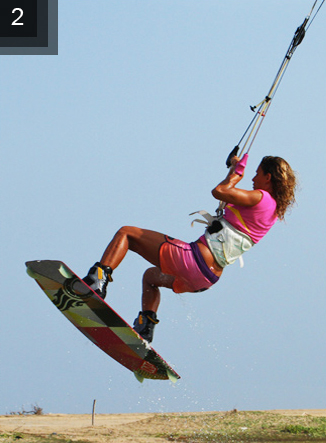 ’t mean that you must be holding the board as soon as fins departs the water, however if you place your body in right position then grab will be trouble-free to obtain. Rider lifts both knees up and this helps with slowing the rotation down. Also you can’t toss your head around into the rotation if you are seeking a firm grab.
’t mean that you must be holding the board as soon as fins departs the water, however if you place your body in right position then grab will be trouble-free to obtain. Rider lifts both knees up and this helps with slowing the rotation down. Also you can’t toss your head around into the rotation if you are seeking a firm grab.
Image number – 3
If you succeed in carrying you’re both knees right up into your chest height then the grab must be a child play for you. The blockages with the Indy are your control and the kite. Here the kite lifts you and strap up holds and you will be planning to aim the right for the middle of your board.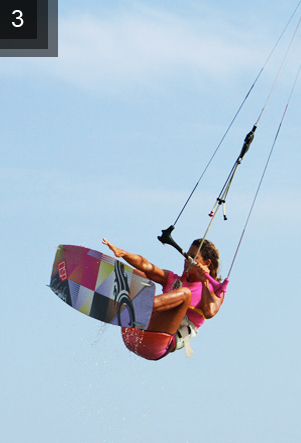 Bring the board up towards your extended hand; please let your stomach and legs do the work here as you can’t bend down with such force. Permit your head & shoulder to rock back into a comfortable sitting position as your knees comes up. You can also observe here that the rider hasn’t rotated much since the last image. Rider is rotating slowly and is quick to get the board up.
Bring the board up towards your extended hand; please let your stomach and legs do the work here as you can’t bend down with such force. Permit your head & shoulder to rock back into a comfortable sitting position as your knees comes up. You can also observe here that the rider hasn’t rotated much since the last image. Rider is rotating slowly and is quick to get the board up.
Here, while seeking for the firm grabs keep your head between your shoulders and also keep the rotation slow. In this position you will use a large time keeping the bar pulled in with only your front hand, the kite will simply move from behind you to somewhat in front of you.
Image number – 4
Hold it tight, once you get the grab. Slower your rotation & try to hold the grab as long as possible. 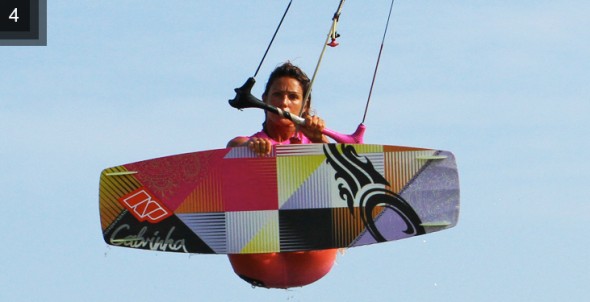 Enjoy it; it’s very cozy as you can also see that rider’s position in the air is almost the same as setting on beach. If you have sent the kite solid and frozen it above you while take off, you must be able to settle down and except you sense that kite dragging too far forward, oppose the enticement to look over your shoulder.
Enjoy it; it’s very cozy as you can also see that rider’s position in the air is almost the same as setting on beach. If you have sent the kite solid and frozen it above you while take off, you must be able to settle down and except you sense that kite dragging too far forward, oppose the enticement to look over your shoulder.
Image number – 5
In this position, If your rotation is controlled and the kite is not too far forward you can hold the grab until just before landing. You would eventually need to turn your head over your shoulder to make sure you complete 360 degree and perfec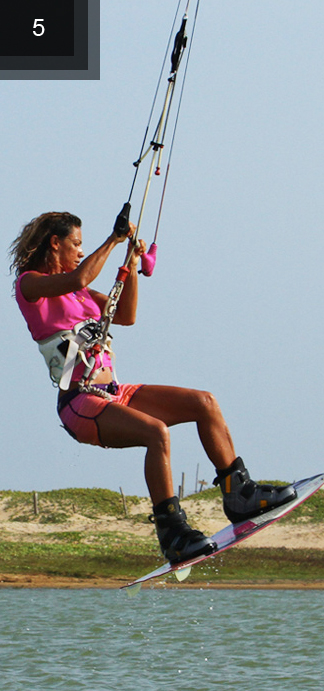 t landing. Mark your landing and obtain the board pointing downwind.
t landing. Mark your landing and obtain the board pointing downwind.
When you discharge the grab, try to get both hands on the bar and provide it a good jump to aid you land downwind.
Top Tips
- Always begin with some back rolls, focusing on the send, upward take off and slow rotation and after that start to take knees up and roll back in your yoke.
- If slow rotation is your problem, then try looming it as you would for a back roll transition, and also with low speed
- you will see it much easier.
- Also have a close look to images
Common Problems
- If you are over rotating your back rolls, ensure that you don’t carve up exceptionally during your take off.
- You must go from the edge that you have approached with and then kick up and around.
- Ensure that you dive the kite for the landing as this will discontinue your revolution and pull you off down wind.
- Ensure your hands are centered on the bar and also keep in mind to send the kite and further it goes back, then it needs to return back. There would be a perfect balance as per kite’s size.
Keystones
- Always send kite positively
- Lift knees and rock then get ready for the grab
- Fine solid edge with straight front leg & back leg resisting
- Pop up into the back roll
- Do turn your head and jump to accomplish rotation
Here is a video that shows how to spice up your back roll with an indy grab
Back Loop to Blind
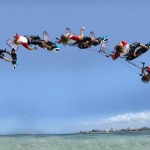
This moves shows an absolute control and beautiful trick in its own right, it is also the final building block to a couple of world class air pass moves. Once nailed you will be the envy of many at your local point, and it will spur you on with a new found confidence to try more technical tricks that not so long ago seemed impossible to reach.
THE BACK LOOP
First, your unhooked popped back loops need to be 100% accurate and controlled. By this we mean that you need to be executing a popped rotation at a slow pace. This will result in your land facing downwind. Such a back loop will also result with your landing with slack lines with no pull from the kite and a feeling that you’re actually dropping down. To achieve this, the three things to remember are the head position, kite and the point of sail. Try not to use your head for rotation, just look forward where you are going to take-off and leave your head square with your shoulders.
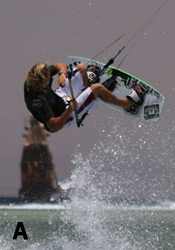 In picture A, the surfer is coming around his rotation but isn’t
In picture A, the surfer is coming around his rotation but isn’t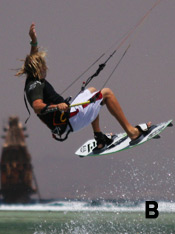 looking over his shoulder. This way you’ll not suddenly be round and landed, but will have that split second to think about throwing it to blind. You need to have the kite a tad lower than your usual measure. If it is 11 or 1, you will be less likely to spin under the kite and there will be something to pull against to get your knees up and the rotation to blind starts as in picture B. You can see the surfer is really pulling his knees in before throwing to blind.
looking over his shoulder. This way you’ll not suddenly be round and landed, but will have that split second to think about throwing it to blind. You need to have the kite a tad lower than your usual measure. If it is 11 or 1, you will be less likely to spin under the kite and there will be something to pull against to get your knees up and the rotation to blind starts as in picture B. You can see the surfer is really pulling his knees in before throwing to blind.
Where you take-off is where you land. So if you want to land more downwind, you need to take-off more downwind. The real advantage of this is that if you start your back rotation in the air, sometime before the board passes through the wind; your brain has time to react and ponder the blind a bit. If you take-off into the wind, you will be able turn around before you have time to pull.
So once again before attempting a back to blind, hammer out back loops to get the first part automatic!
THE BLIND
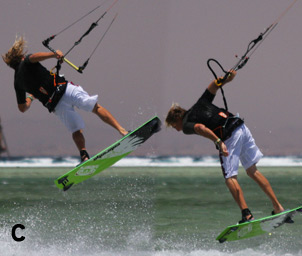 The blind in the Back loop to blind is made more difficult than a front to blind because it is by the fact that not only you are throwing to blind, but you actually have to break your rotation and turn the other way. In the raley, your body is trying to twist the wrong way so it should have trained you in a certain level.
The blind in the Back loop to blind is made more difficult than a front to blind because it is by the fact that not only you are throwing to blind, but you actually have to break your rotation and turn the other way. In the raley, your body is trying to twist the wrong way so it should have trained you in a certain level.
As mentioned already, your head, kite and point of sail will be crucial here. By not looking for your landing over your shoulder, you’ll find it easier to change the direction that your body is travelling in. With the kite lower, your feet will be higher and your body will be in a horizontal position sp you can pull against the bar to stop the initial back rotation and go the other way around. And having taken off earlier, you can rotate more slowly which in turn means that there will be less momentum to fight against.
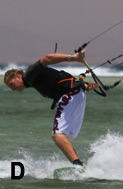 Do not forget to turn your head and twist your wrist, pointing your thumb at where you are going as in picture C. This will help your shoulders turn further, enabling you to turn the board further and stick a more downwind landing with the bar in the right place (picture D) to grab when you go for the surface pass.
Do not forget to turn your head and twist your wrist, pointing your thumb at where you are going as in picture C. This will help your shoulders turn further, enabling you to turn the board further and stick a more downwind landing with the bar in the right place (picture D) to grab when you go for the surface pass.
Once you have mastered a load of back loops, do the same with several raleys to blind and then you will be ready!
SHOWTIME SEQUENCE
Following the sequence which is relatively low and in very light wind will give a good way of confidence. Do not forget to make sure your leash is on the correct side.
pic 1 – The surfer come up over the board flat off and unhooked knowing that the coast is clear. His kite is around 1 o’clock and his hands are together in the middle of the bar.
pic 2 – From a broad reach the surfer carves hard against the power in the kite, front leg extended and back leg flexed and ready.
pic 3-4 – As the board turns upwind, the surfer extend his back leg and pops up. The surfer also keeps his arms bent as this will make the pull in for the twist to blind much easier.
pic 5 – Due to the pop and the kite position, the surfer is pulled into a more horizontal back loop.
pic 6 – As the surfer comes around the back loop, the board is behind and up in the air, almost where it would be during a raley. This is the moment to throw the blind and later on you will miss the chance as the board will start to drop.
pic 7 – The surfer pulls the bar hard towards his front hip to initiate the twist to blind. If the kite were much higher, this would be harder as it would not turn. At the same time the surfer turns his head in the opposite direction and keeps his knees up.
pic 8 – To make sure, the surfer turns far enough and looks around towards the direction of travel.
pic 9 – The surfer will then be able to turn his thumb down and forwards, twisting the bar which moves the shoulders further around, therefore allowing the surfer to get his upper body low.
pic 10 – So now an arc has been created, the surfer can easily pass the bar behind the small arc of his back.
pic 11 – And finally, the surfer turns to face the new direction of travel and sort it out.
Here´s what it will look like when you master this trick:
Downloop S-Bend
We are throwing this just in time for those winter gusts and/or trips abroad. We have noticed quite a bit of a down looping this summer and this is a fairly simple add-on. The move opens up a plethora of possibilities down with super power up. It can deliver some serious arching height and looks great off a wave and is a real crowd pleaser when thrown to blind.
THE DOWNLOOP
The kite downloops when it is sent with the direction of travel by being somewhat aggressive on the front hand side of the bar. It is best to start with the kite at 12 o’clock position.
THE S-BEND
An S-BEND is the most effective way of completing a pop forward rotation when powered up. The primary difference between this and a standard front loop is the take-off. When learning the front loop, we usually throw our head and front shoulder down towards the water, bending and folding in the process as if we were role-playing. Because we have sent the kite, it gives us the necessary lift.
THE FULL MONTY
Like many moves, your first attempts at this are best when you are not clinging onto your bar. Larger kites will give you more lift and time; smaller kites will give turn more quickly, so middle of the road relative to your weight would be ideal. The key to down looping is the timing, more precisely going early.
GO FOR THE GOLD (sequence)
- The surfer carves the kite and starts to move forward. In anticipation, the surfer has compressed his legs to get ready for the launch. The surfer is not waiting to get ripped off the water by the kite, but instead explodes upwards as soon as he feels the kite begins to pull. Up to this phase the surfer could also be going for a straight down loop. (The only difference being that as the rider jumps, he will look over his hands towards the kite for balance and prepare for a downwind landing).
- As the kite starts to pull, the surfer stamps down on the back leg and throws him upwards, literally jumping into the air.
- To initiate the rotation, the surfer has thrown his trailing right shoulder up.
- The kite is now generating a fair amount of pull as it turns good top to toe stretch. This is real commitment time, just hold on and enjoy your flight.
- The kite continues its journey and the yank will in fact pull the surfer around the rest of his rotation.
- The surfer’s only effort is to twist his head and search for the landing strip.
- Once this kitesurfer sees the water, the rest of the body follows suit, the completion of the S-BEND bringing his feet back underneath. If at this stage you feel you still have some height. It is time to let go with the original back right back hand to help slow your rotation and balance the landing.
- On touchdown, the surfer absorbs the impact with soft knees and once they have recovered, the surfer grabs the bar again with the back hand, sails on downwind to hook back in and giggles blissfully.
PROBLEM YOU MAY ENCOUNTER
Ideally, as you land you’ll see your kite once again diving down towards the sea. That means that you can grab the back of the bar and pull the kite out of its dive posture as you hook in.
There are 2 Reasons why the kite does this.
First – If you edge for your country and wait for the kite to physically rip you off the water, the kite will almost have finished a complete loop before you get airborne. To correct this, just think about going early. By this we mean swap your hands, carve and jump up. You should then get the pull in the air, a slower rotation, more height and a sweeter landing.
Second – You are riding in a tiny kite.
TOP TIPS
If you are having trouble finishing your rotation, try starting with the kite higher. It is fairly unnatural to stick the kite at 12 o’clock.
More power in the kite should give you a slower rotation but a more preferred gun blazing downwind strike.
Once you are confident, try using more power. That is to say do not pull the trim strap as far down as you usually would for and unhooked move.
Here are some videos of this kitesurfing trick
Toe Side Pop Out to Wrapped
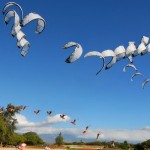
Popping from a toe side and landing in a wrapped is a great start to wrapped if you haven’t tried it before, and if you can already manage a shifty or more to wrapped, then this should be a doodle and a surefire way of adding extra style points to any move you land in toe side.
For those of you who have never tried a wrapped, it is releasing the front hand and rotating away from the bar so that you can reach around behind you and land on heel side with your arm in a self-induced arm lock. If you can go blind one way, imagine going the other way but still releasing with the same hand and turning the exact same way.
LOW AND NEAR
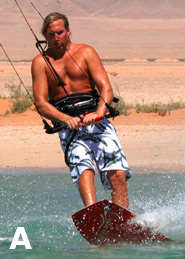 In pic A, you can see that the surfer is almost carving
In pic A, you can see that the surfer is almost carving 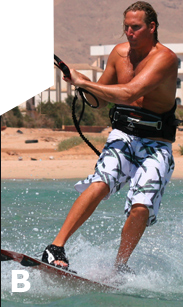 downwind away from his toe side edge. This is very sudden change of direction that does two things. First, it allows you to keep your speed for a moment even without pulling the kite, which means your board will still be planning; therefore you will be able to pop without it sticking. Second, by suddenly turning towards your kite, the lines will slacken and the bar will be light in your hands so you can keep it low and close.
downwind away from his toe side edge. This is very sudden change of direction that does two things. First, it allows you to keep your speed for a moment even without pulling the kite, which means your board will still be planning; therefore you will be able to pop without it sticking. Second, by suddenly turning towards your kite, the lines will slacken and the bar will be light in your hands so you can keep it low and close.
In pic B – Just as the surfer is about to pop, you can see that the bar is in close. With the slack in the lines the surfer can bend his arms and make sure the bar will close to him all the way around his 180 degree spin. You can also see that the kite is relatively low, say around the 45 degree mark. With the kite here it is less likely to pull the bar up and away from you. Also, ( as you’ll be releasing with your front hands) if the kite does move, it will go up, so starting with a lower tad is a good option. If you are popping off flat water, you will need to let go with your front hand as you heave up.
SPEED
As we have already mentioned, you can throw this pop whenever you come fast in your toes from another move. However, when you are trying this for the first time as a pop from toe side, your approach is pretty important because you will need speed. The simplest way to maintain speed is to unhook whilst riding heel side as you will have a better unhooked riding position. Then, you can slide the back of the board straight downwind and you are ready to pop from a very off the wind toe side. However, once you get the hang of it, you could unhook from toe side or just before you pop.
TIMING IN SEQUENCE
1 – Having approached with good speed and his kite positioned at about 10:30, the surfer has unhooked and the spun around to a very downwind toe side chasing the kite. Getting ready to pop the surfer has rocked his weight back over his trailing foot and flexed his back knee. The surfer got his bar in close to his body and is ready to spring.
2 – The surfer stamps down hard on his back foot and extends his body upwards. At the same time the surfer releases his front hand enabling him to stand over the board for a balanced spin.
3 – AS the board rises, the surfer lifts his legs and starts his rotation by turning his head and shoulders down and away from the kite.
4 – The surfer twists his wrist and turns his palm up behind his back, which helps him turn his shoulders further still. At the same time the surfer pushes his left foot through to get the board in front of him.
5 – On landing, the surfer makes sure that the bar is twisted all the way around and ready to be grabbed.
6 – The surfer reaches with this free left hand and grabs the bar.
7 – then releases his right hand.
8-9 – The surfer continues to turn his head and looks up towards the bar and gets both hands back on the bar.
10 – Sail away, hook back in and then try it from a railey to toe side.
KEYSTONES
- Speed
- Sudden chase kite
- Pop hard off back foot
- Turn head all the way
- Twist wrist and shoulders
Unhooked Popped Front Loop
In continuation of out front loop fest, we thought it high time to introduce and familiarize the baby brother of the much respected S-bend, the Popped Unhooked Front Loop. Not only does this move dazzle, but also it is a foundation for a whole other world of kiting techniques that may or may not intrigue you. In addition to that, all this unhooked malarkey (if you’re tempted) is just as well practiced on those underpowered summer days, so give it a shot.
Popping, front looping and a basic unhooked Raley would be a small requirements, along with a modern safety system that lets you both spin and unhook without risking any third party members of the public or kite surfing community.
To help you learn all the important ingredients of an unhooked popped front, we’ll take another look at unhooking, a little glance at popping and way up the differences of popped front compared to a sent front loop.
DETACHMENT
The simplest way to make unhooking controllable is to understand how your kite is trim, thus your bar position will effect what’s going on.
For unhooking, it is vital that you use the strap to trim your bar’s sweet spot so that it rests just above the chicken loop. This way, the bar will feel light and the kite will drift forward, allowing you to be powered up yet in control. Every kite is unique, but it’s more time consuming getting it right. If you don’t trim the sweet spot down, your kite will most likely flare, pulling you off downwind, falling out of the sky in the calms and making kite surfing in general fairly unkind.
Pics 1 & 2. You can see that the surfer is sailing along hands centered with bar trimmed down, flattens the board off by abruptly standing up and almost carves, putting weight over the rear foot. This sudden change in direction towards the kite releases the tension off the lines.
Pic 3. With the tension gone, the surfer pulls the bar in and pushes it down to let the chicken loop slide out from the hook. Without looking down, as this would prevent the hips to move back and make unhooking difficult.
Pic 4. As the chicken loops drops out, the surfer must start to carve into pop before losing speed. Head positioned forward in direction as to where the surfer wishes to go, moves weight and hips right back over the rear foot and straightens the front leg, while dropping upwind off the board to get it back on an edge.
Pics 5 & 6. The surfer tries to maintain shoulders, back and front leg straight when carving hard against the pull of the kite. The goal is to explode up off the rear leg once it gets unstable, must also try and maintain equal pressure on both hands, as it is easy to pull on the back hand and hurl the kite up.
HANDS OF TIME
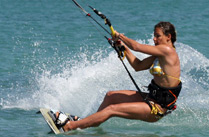 It is essential that you provide a good pop, as this will give you enough time to complete your spin. Your body position in the last stage of the carve will either offer you the chance to explode up or let you be dragged low over the edge which you do not want. In the picture to left, you can see that just before take-off, the surfer positioned the buttocks low to the water, shoulders have not been pulled forward the hips, front leg is extended to keep the edge and push the weight back over the tail of the board, rear leg is flexed in preparation to explode and is looking forward, which will prevent carving too far into the wind.
It is essential that you provide a good pop, as this will give you enough time to complete your spin. Your body position in the last stage of the carve will either offer you the chance to explode up or let you be dragged low over the edge which you do not want. In the picture to left, you can see that just before take-off, the surfer positioned the buttocks low to the water, shoulders have not been pulled forward the hips, front leg is extended to keep the edge and push the weight back over the tail of the board, rear leg is flexed in preparation to explode and is looking forward, which will prevent carving too far into the wind.
A PLACE IN THE SUN
To support this, don’t park your kite at a 45 degree angle, that’s for some time in the future. You need to catch a comfortable height where you are comfortable edging like this, without the kite providing too much lift, but which will also give you a tad of extra bounce off the water. 11 or 1 o’clock would be a decent place to begin.
THE DIFFERENCE IS WHY
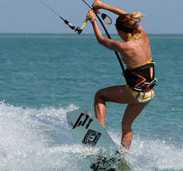 Your pop is going to spring you up off the water, and thus your front rotation needs to compliment this. In a standard front loop when the kite is utilized for height, you’re more than likely to throw your head and shoulders down and around to start rotating. This works because the kite gives you an up force.
Your pop is going to spring you up off the water, and thus your front rotation needs to compliment this. In a standard front loop when the kite is utilized for height, you’re more than likely to throw your head and shoulders down and around to start rotating. This works because the kite gives you an up force.
When popping, if you throw your head down towards your front shoulder, you’ll be neutralizing all the good work you’ve done getting up off the water by forcing your body weight down, and that would be counterproductive. Instead, you need to lift your chin and turn to look up and over the back shoulder as your rear leg extends, see picture on your left hand.
To some, this does not seem to be essentially wise, as you are straightening your back and turning it towards possible impact, whereas the original front loop was a safe roll as if you were crumpling up to break a fall. The second difference is your body can stay extended in a popped front loop, whereas in the jumped version, you are trying make yourself a bit compressed.
ALL IN THE HEAD
Your head is the key to completing this rotation. Half way around you are in prone position, because the kite will be pulling you forward, you will not be able to force your hips, legs and board around in front of you, while your legs are hanging behind and upwind of you.
To finish your spin, you’ll need to look over your shoulder at where you wish to go and then push your hands around to follow. By doing this, your upper body will be facing downwind and the rest will have to follow.
STEERING WHEEL
There is a tendency to pull on the back hand as you carve against the kite. This is more than normal, but it should be avoided. However, if you do find your kite drifting up, give it up a pull on your front hand and a push on the other hand as you come around your rotation. If this still doesn’t help, try pulling on your front hand as you take off.
ALL IN SEQUENCE
- Park the kite in 11 o’clock. Carve hard upwind for maximum pop. Put your weight low and towards the back on the board. Extend your front leg. Ride against the power of the kite whilst looking forward.
- As soon as you feel your shoulders being pulled forward over your hips explode off the water by rapidly extending your back leg.
- Your aim is to spring up and turn your head towards your right arm to initiate the rotation.
- As the kite pulls you forward continue the rotation and keep looking rounds towards your back elbow.
- You are now half way through this trick. You´re facing upwind and are fully powered so you better complete your rotation.
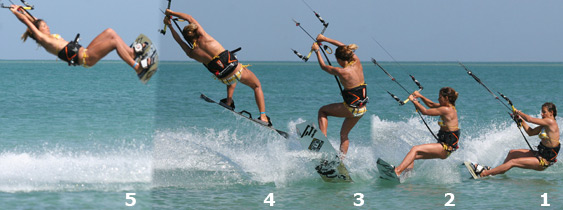
- Try to get a glimpse on where you´re going by spotting a potential landing.
- As your head comes around force your bar and hands around too.
- With your head and shoulders facing forward, the rest of your body follows and you can start dropping down your legs down under you.
- Land the tail first on preferable flat water, slightly off the wind. Soften the knees to absorb the landing and keep looking forward, not down in the water.
- Catch an eye on the kite to make sure that it´s not diving into the water, correct if necessary. Then keep heading towards the kite on a flat board.
- Time to take a hand off and hook back in.
BEST TIPS
Don’t take too much speed into this technique at first, as it’ll feel like you’re in a rush, yet alone rotate and land.
As you develop, you should try and start with the kite a tad lower and keep it still.
As you progress with more power, focus on popping up into the Raley first and then start your rotation.
If your kite is starting to misbehave and is hurling up away, try moving your back hand to the center of the bar with the chicken loop line running between your first two fingers.
A NICE VIDEO OF THIS TRICK
Front Loop from Toe side
Front Loop from Toe side
The front loop from toe side is an extra bit of fun for anyone who wants themselves as proficient toe combo specialists. It is a very attainable move and can lead into a surplus of combos and tricks, both hooked and unhooked, so this is a must have for any promising crowd pleasers around you. As you start from your toes, you’ll find that the kite does a lot of work for you when it comes to spinning. As long as you get the take-off and you keep controlling the kite’s atmosphere, it will be a well aligned move.
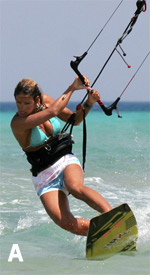 Pic A – The surfer is edging against the kite. Not wanting to draw too much attention to it, but this is another classic kite face trick. If you thought edging upwind requires some effort, now you will edge upwind and try to keep your weight low against the lift of the kite, you will need to use all your steel on it.
Pic A – The surfer is edging against the kite. Not wanting to draw too much attention to it, but this is another classic kite face trick. If you thought edging upwind requires some effort, now you will edge upwind and try to keep your weight low against the lift of the kite, you will need to use all your steel on it.
For starters, trim your bar down towards you. With the bar nearer your body, you will be able to edge well with both hands on the bar, thus being able to send the kite and keep the control on it. Even though the surfer’s bar is angled back to send the kite, the front arm is still bent slightly, so the kite doesn’t pull the surfer around. You can see how the surfer has his neck twisted and face really looking over his shoulder and down. This allows the surfer to commit against the kite and keep the body weight low and forward, whilst still keeping both hands on the bar. This way the surfer is able to hold the edge for that a little bit longer. Just like with a heel side jump move. If the surfer has a cheeky peek at the kite, it will come off the edge.
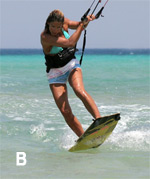 Pic B – Demonstrated the take-off perfectly. The surfer has popped up off the water after the feeling of the rising kite has been felt. Even though you use the kite for this trick, you need to “go early” because you’ll not be able to resist the same way that you do on your heels. Even though the surfer is extending up, keep the head down and twisted around plus continue to commit the weight upwind against the pull of the kite. It is tempting to drift the kite up slowly, but if you are fairly aggressive, you have more chance of holding your edge until the right time. This is your only chance to give yourself enough height to complete the move.
Pic B – Demonstrated the take-off perfectly. The surfer has popped up off the water after the feeling of the rising kite has been felt. Even though you use the kite for this trick, you need to “go early” because you’ll not be able to resist the same way that you do on your heels. Even though the surfer is extending up, keep the head down and twisted around plus continue to commit the weight upwind against the pull of the kite. It is tempting to drift the kite up slowly, but if you are fairly aggressive, you have more chance of holding your edge until the right time. This is your only chance to give yourself enough height to complete the move.
Also, as the surfer starts to take-off, the bar levels have been off already. This is due to popping up early. As the surfer essentially loses the edge as the pop goes, the kite will fly further back as the surfer pendulum underneath it. Once again this is only possible because the surfer has the bar trimmed in near.
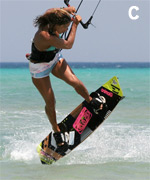 Pic C – The final part of the surfer’s take-off is the initiation of his forward rotation. Just as with a heel side front loop, much of the momentum comes from the back leg kicking off the water, and as the surfer popped off, his back leg will help in that phase. If you look at the surfer’s head, it is no longer looking upwind over his shoulder. By turning his head to look forward and downwind, his body will automatically start to uncoil, and this is a further help by the kite pulling in the harness hook.
Pic C – The final part of the surfer’s take-off is the initiation of his forward rotation. Just as with a heel side front loop, much of the momentum comes from the back leg kicking off the water, and as the surfer popped off, his back leg will help in that phase. If you look at the surfer’s head, it is no longer looking upwind over his shoulder. By turning his head to look forward and downwind, his body will automatically start to uncoil, and this is a further help by the kite pulling in the harness hook.
From here onwards it is all about keeping the bar in and keeping the kite forward while getting your body tucked up and small, so that you can look over your back shoulder and complete the rotation.
Sequences
1-2. With his kite at 1 o’clock and riding with good speed on his toe, the surfer edges hard and sends his kite back for a jump whilst trying to look upwind.
3. As the kite starts to lift up, the surfer explodes up off his back leg whilst committing his weight upwind and of the board.
4. As the surfer kicks off, turns his head and looks downwind under the bar. At this point the surfer is already redirecting the kite forward with his front hand.
5. This impulse coupled with the pulling of the kite, the harness throws the surfer into a front rotation. You can see how the surfer is pulling hard on his front hand.
6. This looks familiar. The surfer is now facing upwind and it looks exactly like a normal front loop. The surfer has the bar pulled in to keep the tension on the lines, the surfer is looking over his back (left) shoulder to continue rotating combing with his knees pulled up to increase the speed of the rotation.
7-8. The surfer keeps looking over his shoulder in an effort to see the water and where to land.
9. As the surfer completes his rotation. The surfer dives the kite hard with his front hand and focuses on his landing.
10. The diving kite pulls the surfer off downwind and stops his rotation. Now the surfer can drop his feet and is ready for the landing stage.
11. The surfer lands tail first with his board pointing downwind for a clean landing. From here the surfer can gather his thoughts before carving back onto his edge and not spinning his bar.
Keystones
1. Trim your kite to get the bar close
2. Edge hard by turning your head upwind
3. Send the kite (do not drift it.)
4. Pop early and turn your head the opposite way
5. Redirect with meaning
And the video:
